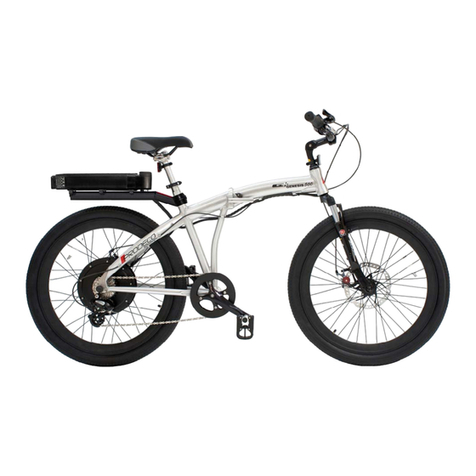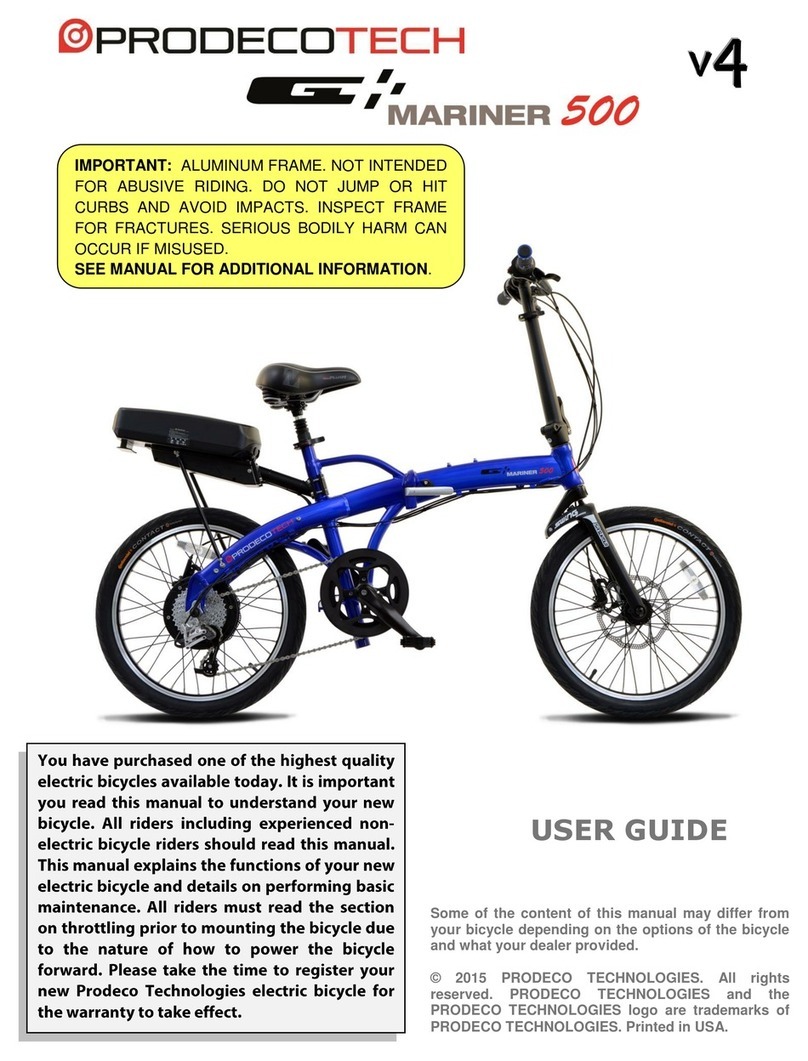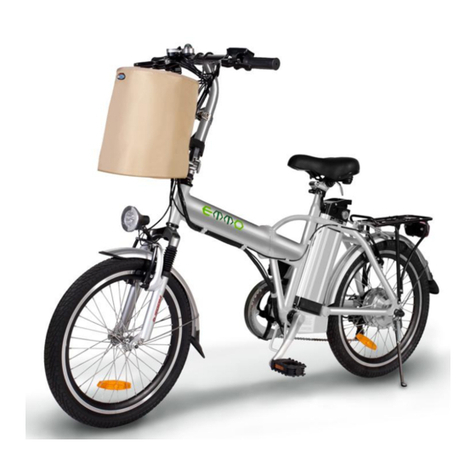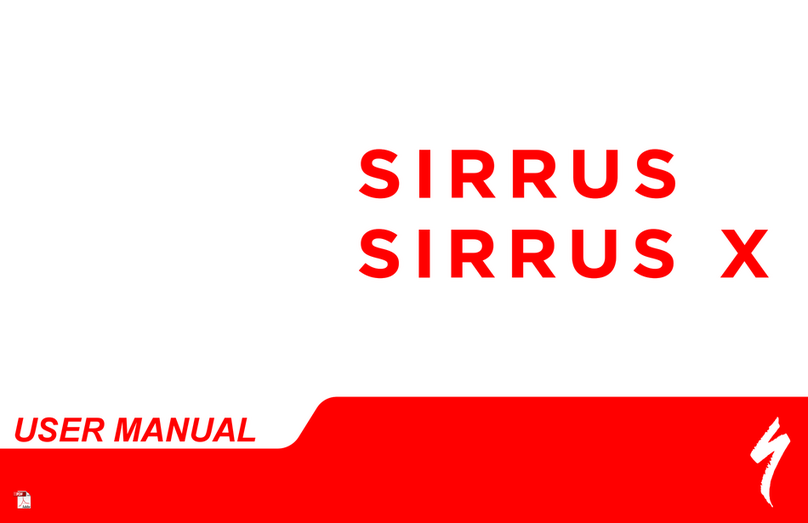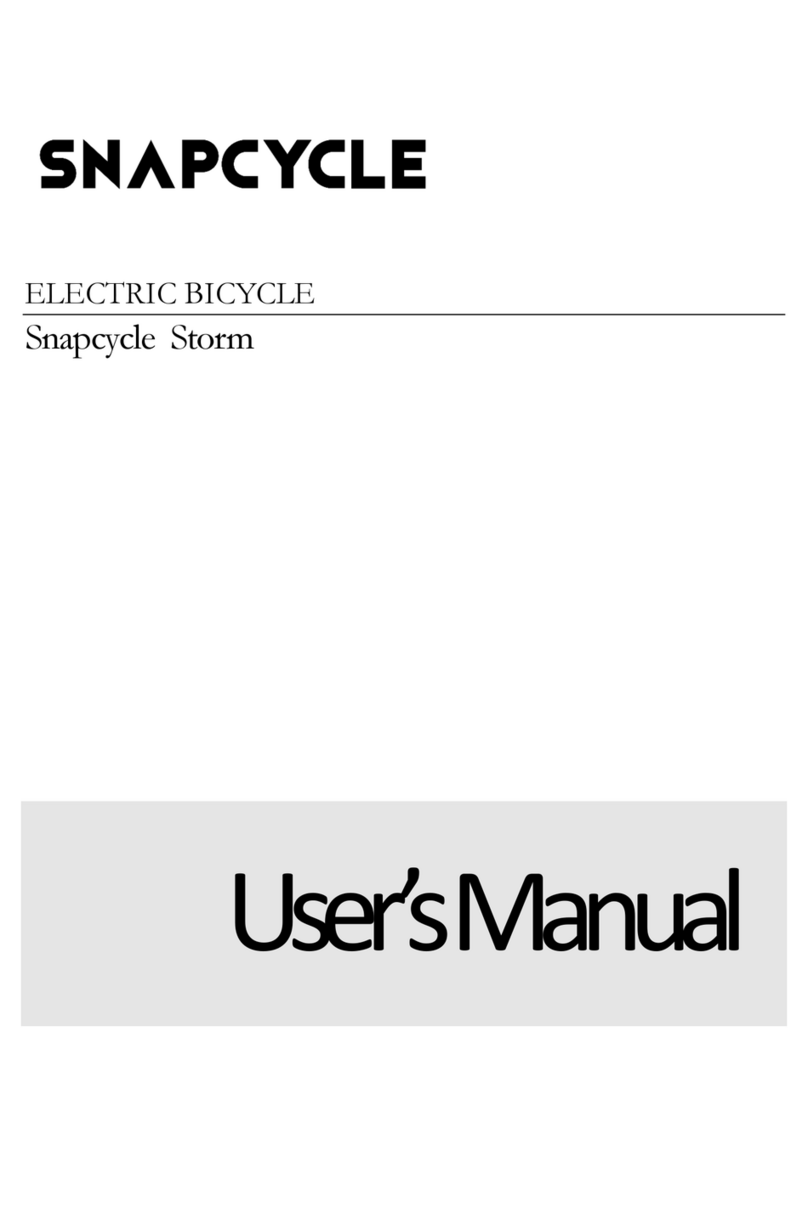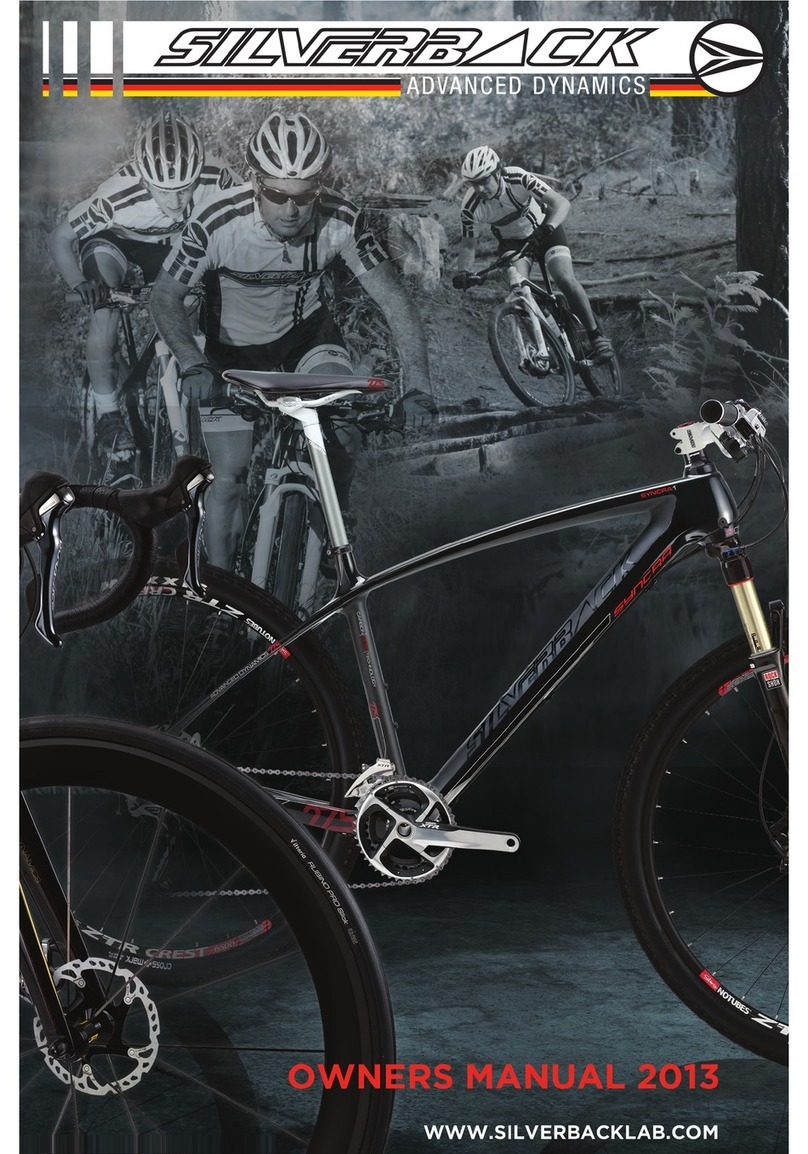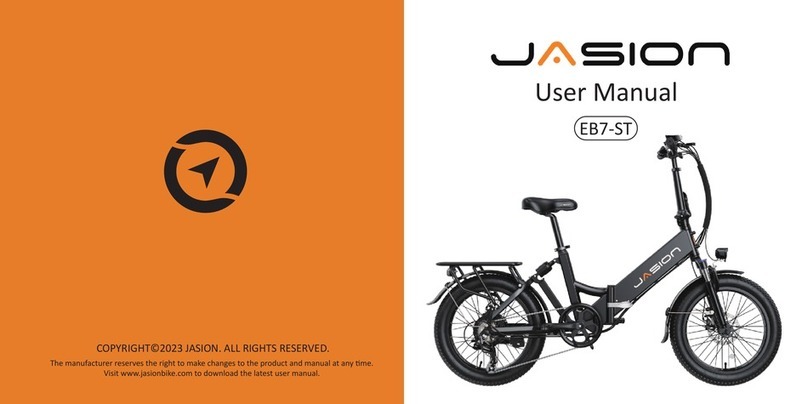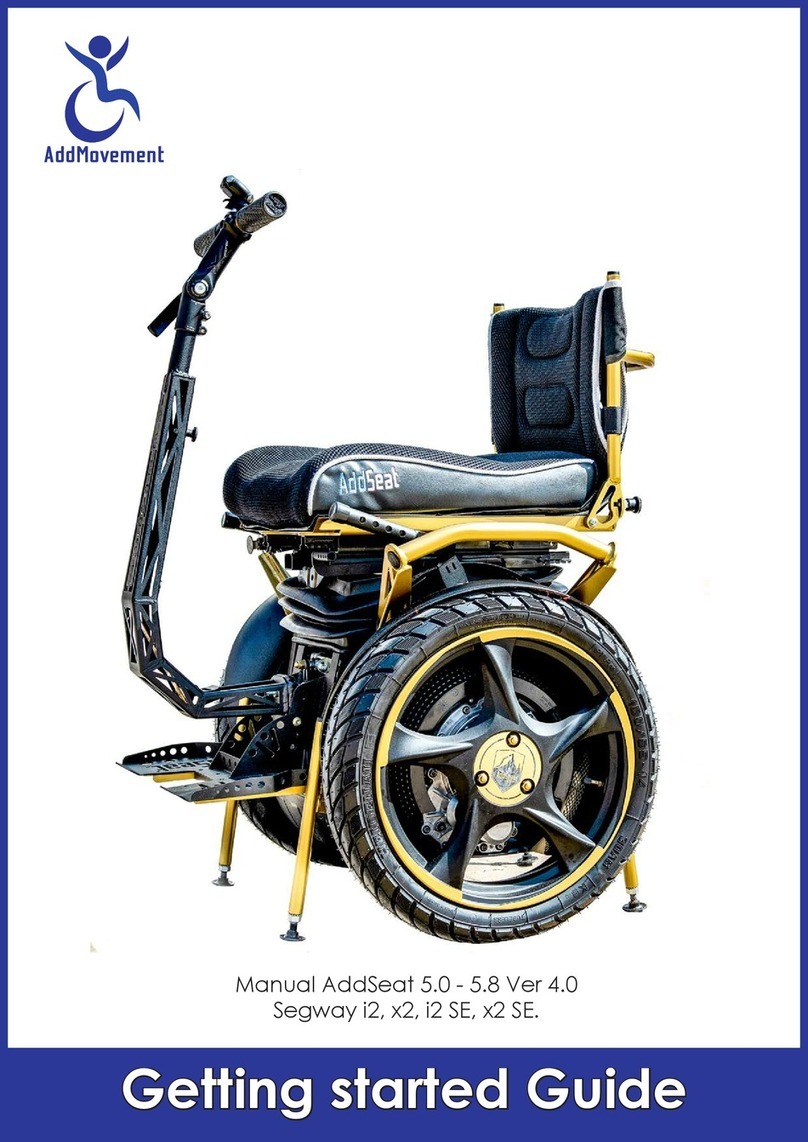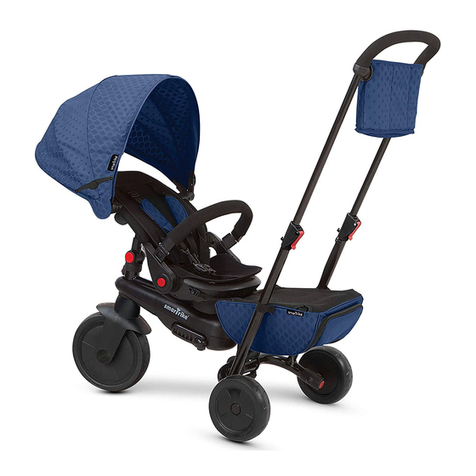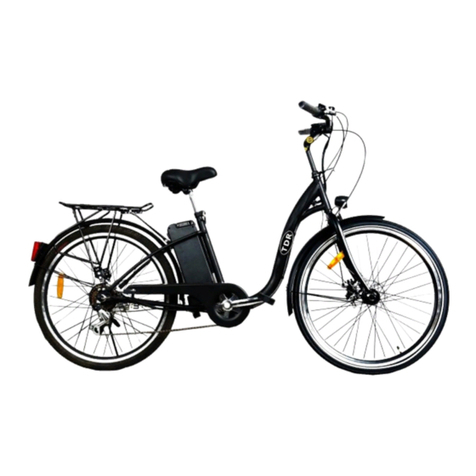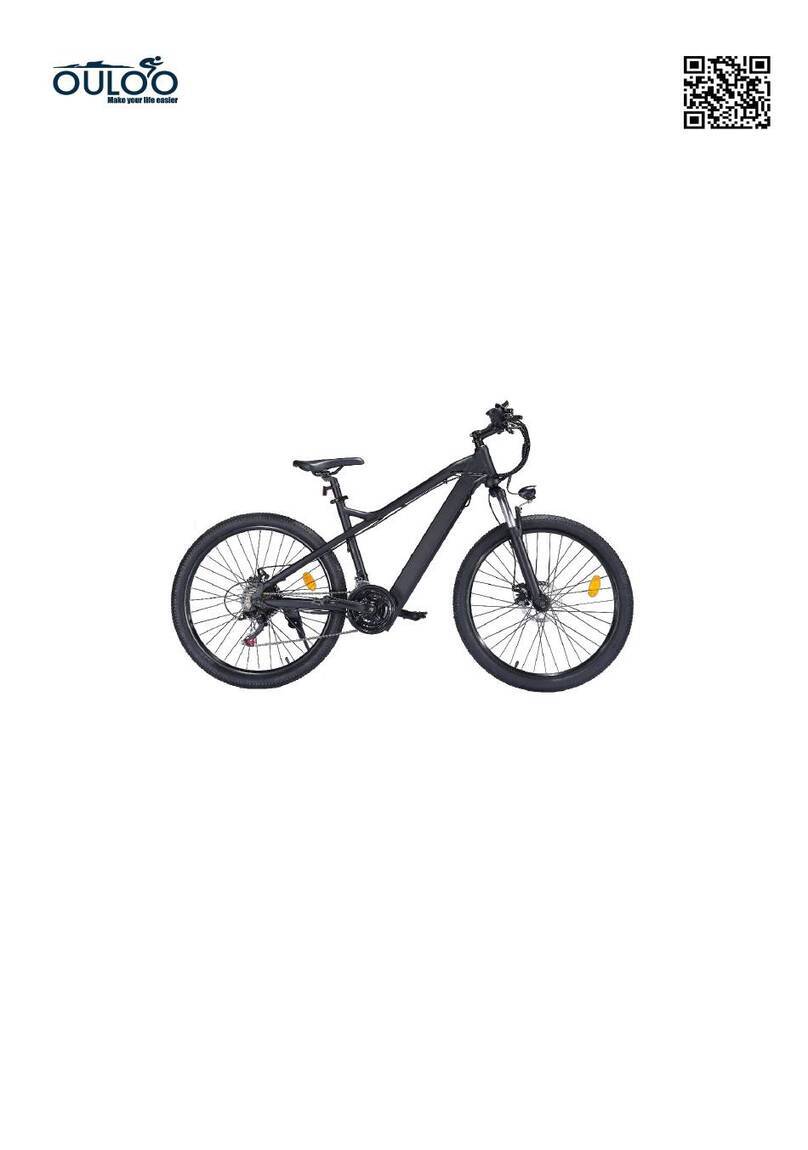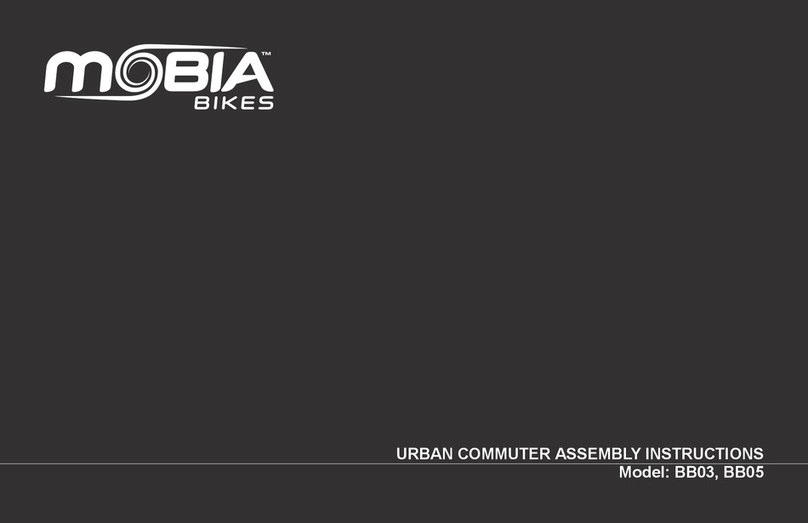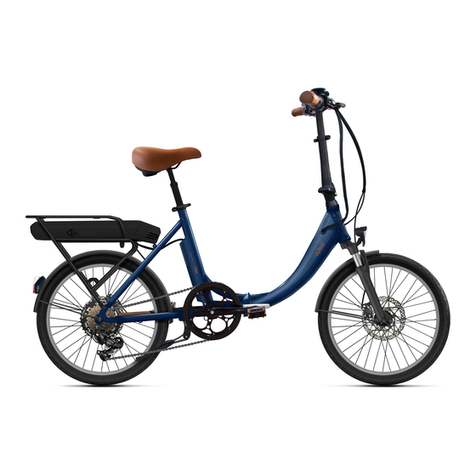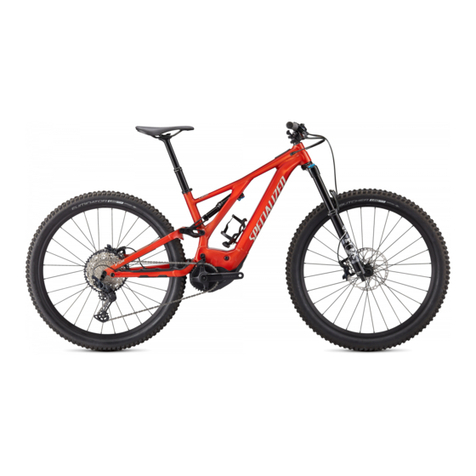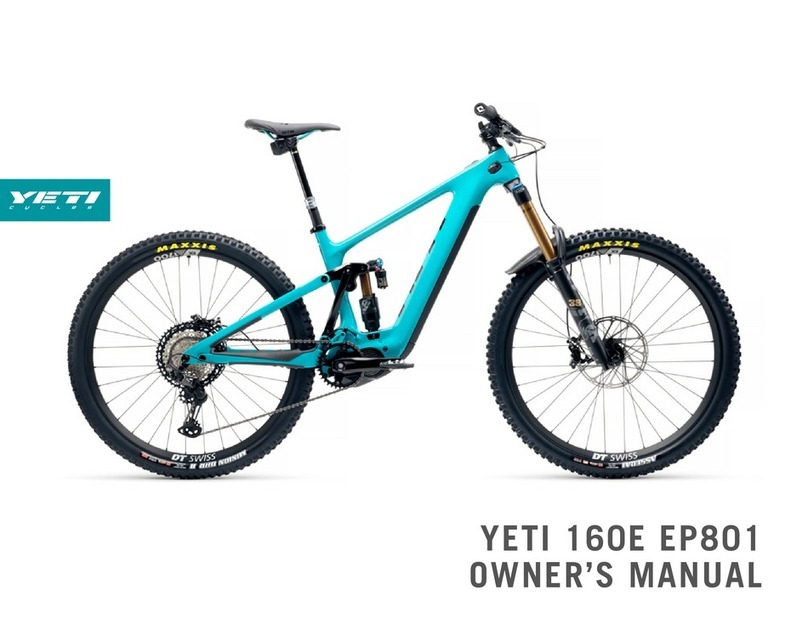Prodeco Technologies Stride 500 User manual

Some of the content of this manual may differ from
your bicycle depending on the options of the bicycle
and what your dealer provided.
© 2013 PRODECO TECHNOLOGIES. All rights
reserved. PRODECO TECHNOLOGIES and the
PRODECO TECHNOLOGIES logo are trademarks of
PRODECO TECHNOLOGIES. Printed in USA.
USER GUIDE
2
2
20
0
01
1
13
3
3
IMPORTANT: ALUMINUM FRAME. NOT INTENDED
FOR HARD RIDING. DO NOT JUMP OR HIT
CURBS, AVOID IMPACTS. INSPECT FRAME FOR
FRACTURES. SERIOUS BODILY HARM CAN
OCCUR IF MISUSED.
SEE MANUAL FOR ADDITIONAL INFORMATION.

WHITE
2
Table of Contents
1) Chapter 1: Introduction ……………………………………………………………………………………………….. 4
a. About this manual ………………………………………………………………………………………………….. 4
b. Important notices ……………………………………………………………………………………………………4
c. General warning …………………………………………………………………………………………………….4
d. A special note to parents ………………………………………………………………………………………….. 5
2) Chapter 2: Getting Started …………………………………………………………………………………………… 5
a. Unpacking your box ……………………………………………………………………………………………….. 5
b. Familiarize yourself with your bicycle‘s parts …………………………………………………………………… 5
c. Contents of the box ………………………………………………………………………………………………... 6
d. A guideline of your Stride 500 tool set …………………………………………………………………………... 6
e. Registering your new bike ………………………………………………………………………………………… 6
3) Chapter 3: Basic Instructions ……………………………………………………………………………………….. 6
a. Bicycle fit ……………………………………………………………………………………………………………. 6
b. Adjusting the saddle …….…………………………………………………………………………………………. 6
c. Installing and adjusting the handlebar stem ………………………………………………………….…………. 7
d. Your local electric bicycle and bicycle laws …………………………………………………………………..….8
e. Safety first …………………………………………………..………………………………………………………. 9
f. Mechanical safety check ………………………………………………….………………………………………. 9
g. Before your first motorized ride ……………………………………………..……………………………………. 10
h. First motorized ride ……………..…………………………………………………………………………………. 10
i. Riding an electric bicycle …………………………………………….……………………………………………. 10
j. Using your throttle …….…………………………………………………………………………………………….10
k. Using your brakes …………….…………………………………………………………………………………….11
l. Pedaling ……………………….……………………………………………………………………………………. 11
m. Shifting gears ………………………………………………………………………………………………………. 11
n. Watching for obstacles around you ……………………………………………………………………………….11
o. Safe riding in various conditions ……………………………………………………………………………….….11
p. Charging your battery ……………………………………..………………………………………………………. 11
4) Chapter 4: Safety ………………………………………………………………………………………………………. 12
a. The basics ………………………………………..………………………………………………………………….12
b. Riding safety ………………………..……………………………………………………………………………….12
c. Wet weather riding ………………………………………………………………………………………………….13
d. Reflectors ……………………...……………………………………………………………………………………. 13
e. Night riding …………….…………………………………………………………………………………………….13
f. Adding accessories ……..…………………………………………………………………………………………. 13
5) Chapter 5: Perfect Fit and Ride ……………………………..………………………………………………………. 13
a. The basics …………………...……..………………………………………………………………………………. 13
b. Frame size ………………………..……………………………………………………………………………...….14
c. Recommended sizing ……………..………………………………………………………………………………. 14
d. Control position adjustments ………………………..……………………………………………………………. 14
e. Brake lever height adjustments ………………………..…………………………………………………………. 14
f. Suspension fork adjustment ………………………..……………………….……………………………………. 14
6) Chapter 6: Tire, Tube, Wheel or Axle Repair ……………………………………………………………………… 15
a. Removing the rear motor wheel ………………………..………………………..………………………………. 15
b. Installing the rear motor wheel ………………………..……………………………………………………….….15
c. Removing and installing the front wheel ……………………..………………………………..……………..…. 16
d. Replacing a tube or tire …………...………………………………………………………………………………. 16
7) Chapter 7: Maintenance and Replacement ………...………………………………………………………………18
a. Keeping your bike clean ………………..………………..………………………..……………………………….18
b. Avoid scratching your bike …………………..…………..………………………..……………………………….18
c. Brake bed in and adjustments ………………………………………..…………..……………………………….18
d. Brake pad replacement ………………………………….………………………..………………………………. 19
e. Derailleur adjustments ………………………..…………………………….……..………………………………. 20
f. Wheel check ………………………………..……………..………………………..……………………………….21
g. Lubricating ………………………..…………………………….…………………..………………………………. 21
h. Crankset …………………………………….……………..………………………..……………………………….22
i. Pedals ……………………………………………………..………………………..………………………………. 22
j. Headset …………………………………..………………..………………………..……………………………….22
k. Maintenance schedule …………………………….……..………………………..……………………………….22
l. Torque specifications for common parts ……………....………………………..………………………………. 23

WHITE
3
8) Chapter 8: Battery Management ……………………………………………………………………………………..23
a. About your battery ………………………………………..………………………..………………………………. 23
b. Removing the battery …………………..………………..………………………..………………………………. 23
c. Installing and locking the battery …………….………..………………………..………………………..………. 24
d. Charging the battery ………………………..……………………………………..………………………………. 25
e. Storing the battery ………………………………………..………………………..………………………………. 25
f. Battery power indicator ………………………..………………………..………………………………………….25
g. Battery replacement ……………….……………………..………………………..……………………………….25
h. Battery disposal …………………………………………..………………………..………………………………. 25
9) Chapter 9: Electrical Components ………………………..………………………………………………………… 26
a. HUB motor ………………………………………….……..………………………..……………………………….26
b. Brushless hall sensor controller ……………….………..………………………..………………………………. 26
c. Wiring harness ……………………………………………………………………..………………………………. 26
d. Throttle ………………………..………………………..………………………………………………………...….26
10) Chapter 10: Warranty Service and Repair ………………………………………………………………………….27
a. 2 year limited warranty …………………………………..………………………..………………………………. 27
b. Registering your bike ……..…………………….………..………………………..……………………………….28
c. Serial numbers and where to find them ………………..………………………..………………………………. 28
d. Registration card …………………..……………………..………………………..………………………………. 28
e. Part replacement procedure …………...………………..………………………..………………………………. 29
f. Contacting Prodeco Technologies ……………………..…………….…………..……………………………….29
11) Chapter 11: Specifications …………………….………………………………...……………………………………29
12) Chapter 12: Parts ……………………………………………………..…….…………………………….……….……30

WHITE
4
OPERATIONAL INSTRUCTIONS
Chapter 1: Introduction
Prodeco Technologies thanks you for your purchase of your new Stride 500. Your bicycle is a high qualityand environmentally
friendly light electric vehicle. This manual will serve to provide you with the information needed to operate, maintain andenjoyit
safely. Your electric bicycle should provide you with years of healthyenjoyment provided youfollow these steps.
For technical questions or customer service, please contact PRODECO TECHNOLOGIES at 800.943.6190 or e-mail us
at service@prodecotech.com.
a) About this manual
To prevent serious injury to yourself and others, and to prevent damage to the bicycle please read and understand these
instructions completely before operating your Prodeco Technologies Stride 500. Your new bicycle is a powerful and
reliable electric bicycle. You should use caution and care while getting accustomed to your bicycle‘s riding
characteristics. The following manual will provide basic instructions regarding your bicycle‘s care and maintenance,
battery management, operating procedures, and other important information. You should read it thoroughly before riding
your new bicycle for the first time. If you have any questions that are not answered in this manual, contact your local
authorized Prodeco Technologies dealer or you can call customer service at 800.943.6190.
b) Important notices
Always remove the key from the battery when your bicycle is not in use, replacing a component or performing
maintenance.
Makesure your electric bicycle is properlyfittedto you as described in Chapter 3 ―Basic Instructions‖.
Perform the mechanical safety check describedin Chapter 3 ―Basic Instructions‖ section f ―Mechanical safety check‖ before
each ride.
You should ride your Stride 500 as a traditional bicycle under pedal power prior to riding under motor power for the first
time.Thiswill allowforthe familiarizationof how your Stride500rides and balances.
When riding under power for the first time, press the variable throttle very slowly only after pedaling to a slow speed to
understand the strength of the front motor‘s performanceandgrip on the roadsurface.
Always applyfullfront & rear brake lever pressurewhen attempting to mount or dismount the bicycle.
When attemptingtomountordismount the bicycle,thekeyshould be in theoff positiononthe battery.
Please read the battery pack and detailed charging instructions found in Chapter 8 ―Battery Management‖ before charging
the battery pack forthe firsttime.
Youshouldfullycharge the Li-ionLiFEPO4 batteryaccording to the charginginstructionsbeforeyour first ride.
You should always fullycharge your Li-ionLiFEPO4 batteryevery10miles regardless of the amount of small trip distances.
You should always fullycharge your Li-ionLiFEPO4 batterypack after eachroundtrip rideexceeding7.5 miles.
Alwaysstorethe batterypack in a cool and dryplace.
During periods of prolonged storage, the battery pack should be charged at least once every 6 months at a minimum of
60%orevery3 months at 40%. Donotcharge higher than60% when storing.
Your Stride 500 can be ridden as a traditional bicycle; it is strongly recommended that you also assist with pedaling when
ridingwhichcan greatlyincreasethe distance between batterycharges.
When ridingunder power, you can enhancedistance in between charges by holdingthe throttleat 10%belowfull throttle.
When riding under power, add as much non-powered coasting (similar to traditional pedaling) byreleasing the throttle and
allowingthe bicycle to freelycoast underits own momentum.This will greatlyincrease the distancebetween charges.
Familiarize yourself with throttling (10% below full), pedaling and momentum coasting to optimize the distance being
available per charge. If planning a long trip, applying a combination of the 3 distance enhancing methods mentioned above
will allow for anuninterrupted powersupplyfortheentire ride.
c) General warning
Like any sport, bicycling involves the risk of injury and damage. By choosing to ride a bicycle, you assume the
responsibility for that risk, so you need to know —and to practice —the rules of safe and responsible riding and of
proper use and maintenance. Proper use and maintenance of your bicycle reduces risk of injury.
This Manual contains many ―Warnings‖ and ―Cautions‖ concerning the consequences of failure to maintain or inspect
your bicycle and of failure to follow safe cycling practices.
WARNING: This image followed by the word WARNING indicates a potentially hazardous situation that,
if not avoided, could result in serious injury or death.
CAUTION: This image followed by the word CAUTION indicates a potentially hazardous situation, which,
if not avoided, may result in minor or moderate injury, serious, damage to the bicycle or the voiding of your
warranty or is an alert against unsafe practices.
Many of the Warnings and Cautions say, ―you may lose control and fall‖. Because any fall can result in serious injury or
even death, we do not always repeat the warning of possible injury or death. Because it is impossible to anticipate every
situation or condition that can occur while riding, this Manual makes no representation about the safe use of the bicycle
under all conditions. There are risks associated with the use of any bicycle which cannot be predicted or avoided, and
which are the soleresponsibility of the rider.

WHITE
5
d) A special note to parents
The Prodeco Technologies Stride 500 is intended foruse by adultriders only. Manystate laws require electric bicycle riders to
be a minimum age of 16 with some states having minimum ages set as low as 10 years old and other states up to 18 years
old (at the time of the writing of this manual). As a parent or guardian, you are responsible for the activities and safety of your
minor child including the following of your state and local laws in regards to the riding of an electric bicycle by a minor (under
the age of 18). That includes,if your state allows a minor toride, making sure that your minor child can safelyride and control
allof the operations of the bicycle, andfullyunderstands all warnings and cautions as indicated in this User Guide. Please read
on if you have determined that your minor child can legally and safelyride and control all of the operations of the bicycle. That
includes makingsurethat the bicycle is properlyfitted tothe child; that it is in good repair and safe operating condition; that you
and your child have learned and understand the safe operation of the bicycle; and that you and your child have learned,
understand and obey not only the applicable local motor vehicle, bicycle and traffic laws,but also the common sense rules of
safe and responsible bicycling. As a parent or guardian, you shouldread and understand this manual. Beforeletting any child
ridethe Stride500 or any of ProdecoTechnologies electric bicycles, review with them all warnings andcautions; as well as the
information on the proper usage of your battery pack, charger and bicycle. You must first confirm the laws, rules and
regulations regardingelectric bicyclesin your state, cityand local municipality.
WARNING: Make sure that your child always wears an approved bicycle helmet when riding; but also
make sure that your child understands that a bicycle helmet is for bicycling only, and must be removed when not
riding. A helmet must not be worn while playing, in play areas, on playground equipment, while climbing trees, or
at any time while not riding a bicycle. Failure to follow this warning could result in serious injury or death.
Chapter 2: Getting Started
CAUTION: If you have purchased your bicycle by mail order or through a sales channel whereas your new
Stride 500 is still in the box, it is recommended you read Chapter 3 “Basic Instructions” section g “Before your first
ride” prior to your first ride.There may be additional adjustments required due to shipping by thefreight carrier.
a) Unpacking your box
Your Stride 500 arrives fully assembled in it‘s box and only requires the insertion of the seatpost and handlebar stem.
You can learn on how to insert the seatpost and adjust for your height in Chapter 3 ―Basic Instructions‖ section b
―Adjusting the saddle‖. The insertion of the stem and tightening of the stem bolt is detailed on Chapter 3 ―Basic
Instructions‘ section c ―Installing and adjusting the stem‖.
The Stride 500 has been fully tested and adjusted prior to being packed in the Heavy Duty double wall box with a
form fitting interior support system. To remove the Stride 500 from it‘s box, open the top flap of the box and remove
the top protection insert. Place one hand under the front portion of the frame and the other hand under the center of
the frame. Pull up slowly and the bicycle will lift out of the box. Remove the additional inserts (if attached to bicycle)
and set the bicycle down by balancing the bicycle on the opened kick stand and both wheels. The kick stand also
performs as a crankset protector. To unfold the bicycle, read the following paragraph, section b.
b) Familiarize yourself with your bicycle’s parts

WHITE
6
c) Contents of the box
Check the contents of your box. Your new Stride 500 should include the following items in the box or your dealer should
have included these items with your purchase:
Stride 500 electric bicycle
Prodeco Stride 500 saddle (seatpost attached)
Prodeco Technologies 36V12Ah LiFEPO4 battery
36V LiFEPO4 charger
Charger power cable
2 keys
Multi-use nickel plated tool set
6mm Hex Key
2 cable ties (for future use)
d) A guideline of your Stride 500 tool set
The Stride 500 includes a multi-use tool set. This tool set includes all the tools necessary to make adjustments and
service your new bicycle. The only additional tool you will ever need is an 18mm wrench to remove the front wheel. All
other tools are included with the tool kit. The tool kit includes the following tools:
Philips Screwdriver
Flat Head Screwdriver
2mm Hex Key
2.5mm Hex Key
3mm Hex Key
4mm Hex Key
5mm Hex Key
6mm Hex Key (2)
8mm Hex Key
Torx 25
9-15mm Socket Set
Tire Levers
e) Registering your new bike
For the warranty to take effect, you must register your new bicycle. Registration of your electric bicycle is the only waywe
can acknowledge and verify the established owner. Your bicycle has 3 individual and unique serial numbers (frame,
motor and battery). Each serial number must be registered when filling out the registration form. The serial number on
the frame is located under the crank/bottom bracket portion of the frame. The serial number for the motor is found on the
motor‘s side. The serial number for the battery is located on the barcode label adhered to the underside of the battery.
These numbers should be recorded and registered in case of warranty issues or theft. Please review Chapter 10
―Warranty Service and Repair‖ section c ―Registering your bicycle‖ on registering your Stride 500. You can register by
either filling out the online registration form at www.prodecotech.com/register-your-bike/ or by sending the registration
card found in Chapter 10 ―Warranty Service and Repair‖ section d ―Registration card‖.
Chapter 3: Basic Instructions
a) Bicycle Fit
It is very important your Stride 500 is properly adjusted for comfort and to avoid the possibility of losing control while
riding. The saddle and handlebar have adjustments available to allow riders from 5‘ 6‖ to 6‘ 6‖ to set the proper
measurements allowing for a safe and comfortable riding position. There are saddle height, rotation and distance to
steering tube adjustments and also a handlebar height and rotation adjustment. If you plan to use your electric bicycle
also as a traditional pedal bicycle, it is recommended you adjust the saddle height to allow for a full leg extension when
pedaling. The ball of your foot when resting on the pedal should only allow for a slight bend at the knee when seated.
Please review the following points in determining how to make the correct adjustments. The subsequent sections will
assist you with making these adjustments.
1) Is your bike adjusted to you and your size?
2) To check, see Chapter 5 ―Perfect Fit and Ride‖. If your bicycle is not properly adjusted, you may lose control and fall.
3) Is the saddle at the right height? To check, see Chapter 5 ―Perfect Fit and Ride‖ section a ―Stand over height‖.
4) Are saddle and seat post securely clamped? A correctly tightened saddle will allow no saddle movement in any
direction. See Chapter 3 ―Basic Instructions‖ section b ―Adjusting the saddle‖ for details.
5) Are the stem and handlebars at the right height for you? To check, see Chapter 5 ―Perfect and Ride‖ section c
―Handlebar height and angle‖. If not, see Chapter 3 ―Basic Instructions‖ section c ―Installing and adjusting the
handlebar stem‖and it will explain how to adjust.
6) Can you comfortably operate the brakes? If not, you are able to adjust their angle and reach. See Chapter 5 ―Perfect
Fit and Ride‖ section e ―Brake lever height adjustments‖ for details.
7) Do you fully understand how to operate your new bicycle? If not, before your first ride, have your dealer or contact us
to explain any functions or features that you do not understand after fully reading this manual.
b) Adjusting the saddle
You have the ability to adjust the height of your saddle instantly via the quick release
clamp. There is also the ability to tilt the nose of the saddle up or down and adjust your
riding position to be further or closer to the handlebar. The latter two require the use of
the multi-use tool included with the purchase of your Stride 500. Please review the
followingdetails on adjusting your saddle.
To adjust the height of the saddle or remove the seat post, no tools are required. The
quick release lever is opened by pulling the lever away from the seat tube allowing
for the seat tube clamp to loosen the grip around the post. This will allow you to raise
or lower the saddle to the desired height. There is a minimum insertion line on the
seat post which must be followed and you must not extend the seat post past this
mark. It is also important the seat tube clamp is tightened sufficiently around the seat
post for it not to slide downwards after the quick release lever is closed. This can be
accomplished by tightening the quick release nut clock wise which is located on the
opposite end of the quick release lever.
WARNING: The seat post includes a minimum insertion mark. It is important you do not allow the seat
post to be clamped below this mark. This mark must be inserted into the frame pass the top of quick release
clamp. If clamping below this mark, it can cause the seat post to break, failure to follow this warning could
result in serious injury or death.

WHITE
7
CAUTION: The seat tube quick release clamp must be checked for tightness to ensure the saddle will not
accidentally slide into the seat tube when riding. This can cause a rider to lose balance and may result in a fall.
To tilt the nose of your saddle upwards or downwards, you will need to use the 5mm hex key included with your multi-
use tool kit that came with your bicycle. The saddle mounting clamp attaches the saddle to the seat post via a front and
rear barrel nut and bolt. To bring the nose of the saddle down, loosen the rear bolt by 1 full counter clockwise rotation
and tighten the front bolt by 1 full clockwise rotation. Check for comfort and if the nose is still too high, attempt the above
step again. Continue to adjust by repeating the step above until the desired nose height is established. If you prefer to
raise the nose, you can follow the above step but in the opposite direction (loosen the front bolt counter clockwise 1
rotation and tighten the rear bolt clockwise 1 rotation). All bolts should be tightened to 140 in*lb. (SEE PHOTOS)
CAUTION: The saddle mounting clamp front and rear barrel nut and bolt must remain tight at all times.
Test saddle for looseness or play in the rotation of the nose. If saddle is loose, tighten the clamp bolts to ensure
the saddle will not accidentally rotate up or down when riding. Both bolts should be tightened to 60 in*lb. If
loose, this can cause a rider to lose balance and may result in a fall.
Your saddle can be adjusted to be closer or further away from the steering tube/handlebar (you will need to use the 5mm
hex key included with your multi-use tool kit). This adjustment is minimal but allows a 7.5mm adjustment in either
direction from center mount (15mm total, close to 5/8‖). To adjust the saddle closer or further, you must loosen the rear
and front barrel nut and bolt set which connects the saddle rails to the saddle mounting clamp located at the top of the
seat post. Loosen both bolts by rotating 2 times counter clockwise each. This should allow for sufficient looseness to
slide the saddle rails in either direction on the saddle mounting clamp. You must not allow the edge of the saddle
mounting clamp to meet with the saddle rail bends. The edge of the clamp must be a minimum of 5mm from the saddle
rail bends. Upon establishing the correct position, tighten the saddle mounting clamp bolts 2 times in clockwise direction.
Check for tightness of bolts and continue turning if loose. All bolts should be tightened to 140 in*lb. (SEE PHOTOS)
CAUTION: The saddle mounting clamp front and rear barrel nut and bolt must remain tight at all times.
Test saddle for looseness or play in the rotation of the nose. If saddle is loose, tighten the bracket bolts to
ensure the saddle will not accidentally rotate up or down when riding. Both bolts should be tightened to 140
in*lb. If loose, this can cause a rider to lose balance and may result in a fall.
CAUTION: The edge of the saddle mounting clamp must have a minimum of 5mm of clearance from the
saddle rail bends. If the edge of the clamp is mounted to close the saddle rail bends and the rider does not
position themselves properly on the saddle, this could result in the rails becoming unstable due to the leverage
of the riders weight. The rails can bend and can cause a rider to lose balance and may result in a fall.
c) Installing and adjusting the handlebar stem (SEEPHOTOSNEXT PAGE)
The handlebar and stem of the Stride 500 is shipped not inserted into the steerer tube. The handlebar and stem is temporarily
attached to the frame with shipping ties. Using scissors, cut the ties to free the handlebar and stem from the frame. You will need
to slide the stem quill into the steerer tube and set the stem to the preferred height for riding. The steerer tube is at the inside and
center of the headset. The stem quill must be inserted to the minimum insertion mark located on the side of the quill. Before
inserting the quill, confirm the forks are facing forward and the brake, shift and throttle cables are not twisted. To confirm the forks
are facingforward, the front discbrakerotor should befacing theleftside when sitting on the bike,the sameside as the rear rotor.
Toconfirmthecablesarenottwisted,youmayneedtospinthehandlebar.Thecablesshouldnotbewrappedaroundthestemor
handlebarandfreeofanytype of possiblerestriction.
Onceinsertedto the desired height, removethesmallplasticstem quillboltcoverandusingthe6mmhexkeyof the Ytool, slightly
tightenthestemquillboltbut notfully. You willneedtoalignthehandlebar andstem with thefrontwheelprior tofullytightening.To
align the handlebar and stem,stand in front of the bicycle and hold the front wheel between both knees as not to allow the wheel
to move. Using the grips of the handlebar,align the stem straight with the front wheel. The handlebar itself should crossthe wheel
from leftto right in a perfect straight line and intersect the stem at a 90º angle. Once the handlebar andstem are aligned, you can
nowfullytightenthestem quillbolt.You willneedtotightenatfullforceifusingtheYtool. Atorque wrenchshouldbeusedandthe
stem quill bolt should be tightened to 20.8lb*ft. After tightening the stem quill bolt, reinsert the stem quill bolt cover. It is very
importantthestem boltisproperlytightenedasnottocomelooseduringaride.
The stem can also be adjusted for rise and rotation of the handlebar.When adjusting for rise, the stem will rotate closer and
higher to the rider, allowing for amore upright position. The handlebar should also be rotatedfor proper control adjustments
when adjusting the stem. The adjustable lever is locked in place by a sliding tab. Once adjustment is completed, you must
properly lock the adjustable lever in place afterwards. Anon-locked and opened lever can become verydangerous during a
ride if the stem drops from not being properly tightened. To adjust therise of the stem, locate the sliding tab at the top of the
stem. Using your thumb, slide the tab downwards, unlocking the stem lever. Lift the lever open. The lever must be fully open

WHITE
8
and not half way open to allow the adjusting of the rise and proper rotation of the handlebar. Thefurther you rise and adjust
the stem, you should rotate the handlebar forward. The same in reverse, when lowering the stem, you should rotate the
handlebar backwards, allowing for an adjustment of the controls in a favorable position. Once the adjustment is complete,
push the lever down firmly until the tab locks the stem in place. Check the lever is locked by pulling up on the lever. If the
lever pulls up, push down on the lever once again to lock in place. (See Photos)
WARNING: The handlebar controls will be rotated upwards upon adjusting stem higher. Loosen the 4 stem
binderboltsand rotatethehandlebardownwardsto apreferredriding position.Tightenstembinderboltsto90lbs*in.
CAUTION: The handlebar stem quill bolt and rotation adjustment bolt must be checked for tightness to ensure
thehandlebarstemwillnotaccidentallyslideinto thesteering tubeorthehandlebardoesnot turnthewheelorthestem
rise fallsupon riding.Failuretotightencan cause aridertolosebalance andmay resultina fall.
d) Your local electric bicycle and bicycle laws
Your new Stride 500 was designed to followthe federal guidelines to establish the Stride 500 as a traditional pedal power bicycle
within most USA states and to be allowed to ride in bicycle pathways. However, electric bicycle laws change often and you are
responsible to confirm legal status of the riding of your electric bicycle in bicycle pathways. Below is a reference section on the
USAelectricbicyclefederalguidelines:
Electric Bicycle Laws (please contact your local transportation department for the specific laws in your state and city regarding
ridingelectric bicycles onbikepathways)
Prodeco Technologies offers the following information as guidance and does not guarantee or assure riders they are
followingtherulesandregulationsoftheir state.
Electric bicycle laws may vary by state to state with most states following the classification of that bythe CPSC (Consumer Product
Safety Commission), DOT & NHSTA. Further, the US NHSTA (National Highway Traffic Safety Administration) defines low-speed
electricbicycles(under20mph)alsoasconsumerproductsandnotMotorVehiclesforsafetystandards.TheNHSTAadheresforthe
mostparttotheCPSCguidelines.Weincludedreferencebelowonhow electric bicycles are perceived by the Federal Government‘s
mostimportantagencies.Wedobelievenewregulationandruleswillapplyinthefutureupontheelectricbicyclebecomingoneofthe
standard forms of transportation for the masses. Prodeco Technologies will continue to follow new rules and guidance set forth by
theseagencies,alwayswelcomingandadheringtotheguidelinestheyfeelarerequiredtoassuresafetyfortheelectricbicyclerider.
On October 22, 2008, the Federal Highway Administration (FHWA) updated the Bicycle and Pedestrian Provisions of
FederalTransportationLegislation tomaketechnicalcorrections andclarifications.
Belowaretheimportantupdatesreflectingelectricbicycles:
Motorized Vehicle Use: In general, motorized vehicles are not permitted on non-motorized trails and pedestrian walkways funded
under Title 23. Exceptions to this general rule exist for maintenance vehicles; motorized wheelchairs; when State or local
regulations permit, snowmobiles; and electric bicycles (weighing under 100 pounds and a top speed of less than 20 miles per
hour); "and such other circumstances as the Secretary deems appropriate" (except the Recreational Trails Program which
specificallyprovides funds for motorized trails). In 2008, FHWAdeveloped a Framework for Considering Motorized Use on Non-
motorizedTrails andPedestrianWalkwaystoimplementthe"othercircumstances"provision.
Prodeco Technologies only offers electric bicycles that fall under the category of ―weighing under 100 pounds and a top speed of
less than 20 miles per hour‖. According to the DOT and NHSTA, Prodeco electric bicycles meet the exception of Motorized
Vehiclesandthereforecanberiddenonnon-motorizedtrails andbikepaths permittingstateandlocallaws.

WHITE
9
FrameworkforConsideringMotorized UseonNon-motorizedTrailsand PedestrianWalkways under23U.S.C.§ 217
The purpose of this document is to provide guidanceto Federal HighwayAdministration (FHWA) division offices and a consistent
framework for determiningwhento permitanexceptionformotorized useonnon-motorizedtrailsand pedestrianwalkways under
23U.S.C.§217(h)(5).Therelevantlegislationreadsasfollows:(followingpage)
23 U.S.C. § 217. Bicycle Transportation and Pedestrian Walkways (h) Use of Motorized Vehicles.--Motorized vehicles may
not be permitted on trails and pedestrian walkways under this section, except for-- (1) maintenance purposes; (2) when snow
conditions and State or local regulations permit, snowmobiles; (3) motorized wheelchairs; (4) when State or local regulations
permit,electricbicycles;and(5) suchothercircumstancesastheSecretarydeemsappropriate.
(j)Definitions.--Inthissection,thefollowingdefinitionsapply:
(2)Electric bicycle.--The term "electric bicycle" means any bicycle or tricycle with a low-powered electric motor
weighing under100pounds,with atopmotor-poweredspeed notinexcessof 20 milesperhour.
(4) Wheelchair.--The term "wheelchair" means a mobility aid, usable indoors, and designed for and used by individuals with
mobilityimpairments,whetheroperatedmanuallyormotorized.
Theabove23 U.S.C.§217 offers directionthattheProdeco ElectricBicycles areallowed onbike-paths (non-motorizedtrails)due
toProdecoelectric bicyclesfalling under the classificationoflessthan 100poundsandunder 20mph.
HR 727 SECTION 1, CONSUMER PRODUCT SAFETY ACT
TheConsumerProductSafetyAct(15U.S.C.2051etseq)isamendedbyaddedatthe endof thefollowing:
LOW-SPEED ELECTRICBICYCLES
SEC. 38.(a) Notwithstanding any other provision of law, low-speed electric bicycles are consumer products within the meaning of
section 3(a)(1) and shall be subject to the Commission regulations published at section 1500.18(a)(12) and part 1512 of title 16,
Codeof FederalRegulations.
(b) For the purpose of this section, the term `low-speed electric bicycle' means a two or three-wheeled vehicle with fully operable
pedals and an electric motor of less than 750 watts (1 h.p.), whose maximum speed on a paved level surface, when powered
solelybysuchamotorwhileriddenbyanoperator who weighs170pounds,isless than20mph.
(c) To further protect the safety of consumers who ride low-speed electric bicycles, the Commission may promulgate new or
amendedrequirementsapplicabletosuchvehiclesasnecessaryandappropriate.
(d) This section shall supersede any State law or requirement with respect to low speed electric bicycles to the extent that such
Statelaworrequirementismorestringent than the Federallaworrequirementsreferredtoin subsection(a).
SEC.2.MOTORVEHICLESAFETYSTANDARDS.
For purposes of motor vehicle safety standards issued and enforced pursuant to chapter 301 of title 49, United States Code, a
low-speed electric bicycle (as defined in section 38(b) of the Consumer Product Safety Act) shall not be considered a motor
vehicleasdefinedbysection30102(6) of title49,United StatesCode.
Local BicycleLaws
Most states have their own set of bicycle laws regarding traditional pedal powered bicycles. With most states recognizing electric
bicycles as traditional pedal powered bicycles you must know these laws in your area. Your Department of Transportation or
Cycle Clubs in your area will have the details involving riding a bicycle in your area and your city‘s bike pathways. Requirements
forridingchangeswithareaswithmostcitiesrequiringLEDlights,handsignals,ridingonthecorrectsideoftheroad,ridingbehind
and not parallel to other cyclist, etc…
e) Safety first
It is important you follow your local bicycle laws but also it is important you ride safely. Below are examples of
understanding how to ride your new Stride 500safely.‗
Always wear an approved helmet when riding your bike, and follow the helmet manufacturer‘s instructions for fit,
use and care of your helmet.
Do you have all the other required and recommended safety equipment for your area? It‘s your responsibility to
familiarize yourself withthe laws of the areas where you ride, andtocomply with all applicable laws.
Do you know how to correctly check your wheel axle nuts? Do you understand proper braking techniques? Is your
saddle properly adjusted? How do you power your new electric bicycle? These are all questions you should have the
answers to prior to riding for the first time. This USER GUIDE will answer most of the questions you have in regards to
your new bicycle and assist you in ensuring your electric bicycle remains safe to ride. You should first read the USER
GUIDE in its entirety and familiarize yourself with your new bicycle prior toriding.
For further safety guidelines, please read Chapter 4: Safety
f) Mechanical safety check
Check the condition of your bicycle before everyride.
Nuts, bolts and straps: Make sure nothing is loose. Lift the front wheel off the ground by two or three inches then let it
bounce on the ground. Anything sound, feel or look loose? Do a quick visual and tactile inspection of the whole bike. Are
thereanyloose parts or accessories? If so, secure them. If you‘re not sure, ask someone with bike experiencetocheck.
Tires and Wheels: Make sure tires are correctly inflated, see Chapter 6. Check by putting one hand on the saddle, one
on the intersection of the handlebars and stem, then bouncing your weight on the bike while looking at tire deflection.
Compare what you see with how it looks when you know the tires are correctlyinflated; and adjust if necessary. Are the
tires in good shape? Spin each wheel slowly and look for cuts in the tread and sidewall. Replace damaged tires before
riding the bike. Spin each wheel and check for brake clearance and side-to-side wobble. If a wheel wobbles side to side
evenslightly, or rubs againstor hitsthe brakepads,takethebiketoa qualifiedbikeshoptohavethewheeltrued.
Brakes: Check the brakes for proper operation. Squeeze the brake levers. Are the brakes properlyreleasing?All control
cables seated and securely engaged? Do the disc brake pads grasp the rotors within an inch of brake lever movement?
Can you apply full braking force at the levers without having them touch the handlebar? If not, your brakes need
adjustment. Donotridethebike untilthe brakes areproperlyadjusted.

WHITE
10
Quick Releases: Make sure seat post, rear axle & frame quick release levers are properly adjusted and all are in the
lockedposition.
Handlebar and saddle alignment: Make sure the saddle and handlebar stem are parallel to the bike‘s center line,
clamped andboltstightenedenough so that you can‘t twist them out of alignment. If not, align and tighten them.
Handlebar ends: Make sure the left handlebar grip and right throttle grip are secure and in good condition. If not,
replacethem.
Battery Pack Attachment: Ensure your battery pack is firmly attached to your bicycle before riding. To test battery
attachment, pull up on the batterypack handle after batteryis locked in place. If attachedproperly you will not be able to
slidethe battery off the bike. If not, the battery pack will slideoff the bike.
CAUTION: The braking of your bicycle is one of the highest concerns in safety. Proper brake lever
mounting and cable adjustment is crucial for your brakes to work properly.
WARNING: All Quick release levers must be closed and the clamps or axles tight. One loose quick
release lever can cause the rider to lose control and cause serious injury or death.
WARNING: Loose or damaged handlebar grips or extensions can cause you to lose control and fall.
Unplugged handlebars can cut your body, and can cause serious injury in an otherwise minor accident.
g) Before your first motorized ride
Before your first ride study this manual in its entirety. Make sure you are comfortable and confident when sitting on the
bicycle. If an adjustment doesnot feel right or something feels loose, check to ensure you are properly fitted to the bike and
do a mechanical safety check as explained in the previous section. Make sure you fully charge your battery with the
appropriate charger included with your bicycle. Be sure to firmly attach the battery to the bicycle. Try to slide the battery off
the bike bythe battery handle to confirm proper installation. Read Chapter 3, section h. (thefollowing section) again.
h) First motorized ride
When you buckle on your helmet and go for your first familiarization motorized ride on your new bicycle, be sure to pick a
controlled environment, away from cars, other cyclists, obstacles or other hazards. Ride to become familiar with the
brake levers against throttling, variable throttle performance while pedaling your new bike and not pedaling. The first
motorized ride should be initially pedaling and then slowly pressing down on the throttle to feel the engagement of the
HUB motor. Familiarize yourself with the sensation of power, following these additional guidelines:
Familiarize yourself with the braking action of the bike. Test the brakes at slow speed, putting your weight toward the rear
and gentlyapplying the brakes, rear brakefirst. Sudden or excessive application of the frontbrakecould pitch you over the
handlebars.Applyingbrakestoohardcanlockupawheel,whichcouldcauseyoutolosecontrolandfall(seesectionj.).
Your bike has a front suspension system, familiarize yourself with how the suspension responds to braking
application and rider weight shifts.
Check out the handling and response of the bike; and check the comfort.
If you have any questions, or if you feel anything about the bike is not as it should be, take the bike back to your
dealer for advice or contact Customer Service at Prodeco Technologies.
i) Riding an electric bicycle
Riding an electric bike is similar to riding a non-electric bike but there are some differences to note. An electric bike is
slightly heavier and requires more time to stop due to higher traveling speeds. Your bike is also equipped with a powerful
motor that provides a boost noticeable when starting from a stop. The boost is exhilarating, but you must be comfortable
with the sensation before riding in crowded or congested areas. To maximize battery life, assist with pedaling, engage
throttle to 90% or less and add considerable coasting (pull back to no throttle upon reaching speed) to your riding. Your
batteryis a finite resource and proper riding techniques will prolong its distance per charge.
j) Using your twist throttle
The variable throttle on your Stride 500 was designed to allow you
the abilityto choose the speed to ride at and determine the amount
of torque off the line. The throttle operates similar to an automobile;
the twisting of the throttle mimics the depressing of the accelerator.
The throttle is located on the right side grip and considered a half
twist throttle. It is a half twist, as only the inside portion will twist to
power the bicycle. The grip itself will not twist. Using you forefinger
and thumb, you can safely twist the throttle to propel the bike
forward. A half twistthrottle is used to avoid accidentallytwisting the
full grip when mounting and dismounting the bicycle. Your throttle
also includes a Power ON and Power OFF button. It is the red
button located underneath the LED lights. Depressing the button in
activates the throttle and pressing the button out will deactivate the
throttle.TheON/OFFbuttonisforfurthersafety.Thereisalsoan
LED set of lights which assist in determining the amount of batterystorage capacity remaining. This is discussed in further detail
later in the manual. Throttling is an importantfactor with any electric bicycle and the distanceof travelingavailableper charge. The
higher the speed, the less distance per charge, the faster you accelerate off the line, the less distance per charge. If there are
multiple stops and take offs, this also affects the range of distance per charge. It is recommended you become accustomed to
your style of riding and adjust the style depending on distance needed per charge. For example: if you are planning a short local
trip, full throttle at takeoff and top speed will not be an issue due to your ability to be able to recharge the battery prior to the next
trip. If you are planning a longer trip, 10-15 miles or more, it is suggested you add pedaling, hold throttle back 10% and whenever
possible allow the bicycle to coast under no power. Coasting under no power is similar to riding a traditional pedal powered
bicycle. When riding, a rider will pedal for a few seconds and then stop pedaling, allowing the bike to coast with no power being
used.Thiswillgreatlyincreaseyourdistancebetweencharging.

WHITE
11
k) Using your brakes
Your Stride 500 is equipped with a high performance ―Tool Free‖ adjusting Avid BB7 Disc Brake system. The BB7 front and
rear disc brakes allow your new Stride 500 to stop quickly and accurately. Oversized Avid HS ―Heat Shedding‖ stainless
steel disc rotors are utilized for the axles for increased heat dissipation. When properly adjusted, the Stride 500 high
performance disc brake system offers tremendous stopping power. Prior to leaving the factory, the Stride 500 brakes were
adjusted tight and properly tested. Due to cable stretching from new condition, your brakes may need to be readjusted
within a few weeks of riding. Please refer to Chapter 7 ―Maintenance and Replacement‖, section c ―Brake adjustments‖ to
adjust your brakes for optimum performance. When braking, both brake levers should be applied simultaneously. Your left
brake lever manages your front brake and your right brake lever manages your rear brake. You should first become
accustomed with the stopping power of each brake (front & rear). Test each brake separately in a controlled environment
for their ability to stop the bicycle. Front brakes when locked can cause the rear wheel to come off the ground and the rider
can be thrown off the bicycle. In emergency situations, apply pressure to each brake lever, shift your weight to the back of
the bicycle and only attempt to use full force on the front brakes when the bicycle is not stopping quickly enough. Always
keepa safe distance between vehicles, pedestrians and otherbicycle ridersfrom yourself.
WARNING: Locking the front wheel during braking can cause the rear wheel to lift off the ground and
throw the rider off the bicycle. Both brake levers should be applied simultaneously. In an emergency situation
shift your weight to the back of the bicycle. Locking the front wheel can cause the rider to lose control, be
thrown off the bicycle and cause serious injury or death.
l) Pedaling
Pedaling your Stride 500 is the same as pedaling a traditional bicycle. It is recommended you add pedaling to the power of the
bicycle to enhance the distance per charge. The Stride 500 is a 8 speed bicycle and has the ratio of a 44T front chain ring
(sprocket) against a 11-28T rear freewheel which is designed to offer an easypedaling pace at any speed from 1 MPH to 18
MPH. It is recommended on steep inclines, the rider utilizes the throttle to assist in powering the bicycle up the incline but
simultaneously drop the bicycle to a lower gear. If a rider‘s style of riding is throttle only with no pedaling, distance per charge
will be decreasedand upon a steep incline, the rider is requiredtoassistthe motor bypedaling to powerupthe incline.
m) Shifting gears
The shifting of gears is required to change the ratio of the rotation of pedaling to allow
more or less torque and lower or higher speeds according to one complete rotation of
the crank set. If requiringmore torque, you will shift to a larger rear sprocket for a higher
rotation of pedaling to a lower speed of the rear wheel. To switch to a larger rear
sprocket, you will need to shift to a lower gear. Gear 1 is the largest sprocket which is
28 Teeth and your lowest gear. One full crank rotation creates a 1.57 turn of the rear
wheel. For higher speeds from less rotation of the crankset on flat pathways, you will
shift to a smaller rear sprocket for a higher wheel rotation to a lower crankset speed. To
shift to a smaller sprocket, you will need to shift to a higher gear. Gear 8 is the smallest
sprocket with 11 Teeth and your highest gear. One full crank rotationcreates a 4 turn of
therearwheel.Please review thephoto onshiftinggears.
n) Watching for obstacles around you
Your new Stride 500 travels athigher speeds than most riders are accustomed to, when pedaling a traditional bicycle. It is very
important you are aware of your surroundings and obstacles which may appear near you. You must watch the road surface
you are traveling on which could cause the tires to slip or cause a flat. Examples are soft shoulders, rocks, pot holes, uneven
paths, grates, construction sites. Due to the higher rate of speed when riding under motor power versus pedaling, objects will
advance into your path at a faster rate. Pay attention to other riders in your area, automobiles, motorcycles, pedestrians, poles,
intersections and road signs to name a few. The Stride 500 resembles a traditional bicycle and people walking, driving or
standingmaynot realize you areon amotor powered vehicle and misjudge yourtraveling speed.
WARNING: Hitting a pot hole, soft shoulder or other road deviation may cause you to lose control, be
thrown and cause serious injury or death.
o) Safe riding in various conditions
Riders may find themselves riding in a condition they did not plan on encountering. It is important your new Stride 500 is
maintained properly for optimum performance. Please read Chapter 7 on the details required to keep your electric bicycle at its
best. An unexpected rain storm, snow flurry or night ride could arise during a day‘s trip and you should always be prepared.
PleasereadChapter 4 on Safety, so uponencountering anunexpected riding condition, you willbe confident andready.
p) Charging your battery
The Stride 500‘s battery system is the safest and latest technology in Lithium Ion battery cells and was designed to be
easily charged. Chapter 8 offers a detailed explanation on battery management but the following information is a basic
guide in charging your battery. The battery is a removable device and can be charged on or off the bicycle. If removing
the battery to charge it, please follow these instructions.
Locate the key ignition on the battery and turn the key in a counter clockwise rotation to the ―UNLOCK‖
position. You must push the key in to turn from the ―OFF‖ position to the ―UNLOCK‖ position.
Grab the handle at the back of batteryand carefully pull towards the back of the bicycle to slide off.
The batteryis now transportable and can be charged away from the bicycle when in ―UNLOCK‖ position.
For charging, please review the following instructions.
Lift up the handle of the battery to access the RCA charging input.
Insert the charging plug from the charger into the battery‘s RCA charging input.
Insert the charger‘s power cord into a wall outlet.
The charger‘s LED light will light RED while the charger is charging the battery.
The charger‘s LED light will light GREEN upon the battery being fully charged.

WHITE
12
There is also a battery indicator for checking a full charge. Press the indicator button to display the battery‘s
energy storage. The indicator is located under the batteryhandlebar.
Once the battery is charged, you should discontinue charging and remove the charger.
Unplug the charger‘s power cord from the wall and remove the charging plug from the battery.
You are ready to install the battery pack back onto your bicycle.
To install the battery, first align the bottom of the battery with the batterybase rail.
Once aligned, slide the battery firmly into the battery base and until the battery base terminals insert into the
battery‘s terminal outlets.
Once the battery is properly slid into place, you can then turn the key to the ―ON‖ position.
The LEDs on the throttle in the ―ON‖ position will display a charged battery‘s energy capacity.
Chapter 4: Safety
The manual has detailed safety riding methods. In this chapter we will further discuss additional safety guidelines.
a) The basics
Below is a safetyguideline according to the CPSC (US Consumer Product Safety Commission) in regards to riding a bike.
Always wear a helmet to help prevent head injuries.
Observe all traffic laws andsignals, just as automobiles must do.
Don‘t ride double or attempt stunts.
Ride near thecurb in the same direction as traffic.
Find alternate routes, rather than ride through busyintersections and heavy or high-speed traffic.
Walk -- don't ride -- your bicycle across busyintersections and left turncorners.
Avoid riding in wet weather. When wet, handbrakes mayrequire a long distance to stop.
Avoid riding in the dark. If you do, be sure the bike is equipped with a headlight, a taillight and reflectors.
Apply retro-reflective trim to clothing, or wear reflective vests and jackets.
Avoid loose clothing or long coats that can catch in pedals or wheels. Leg clips or bands keep pants legs
from tangling in the chain.
Avoid crossingraised sewer grates.
Regular maintenance is essential for safe riding. Refer to the maintenance recommendations. If you do not
have basic mechanical skills, an authorized dealer should perform repairs and maintenance.
Align (or "true") wobbly wheels for better control. Spokes also may need adjustment.
Replace all missing, damaged, or worn parts; for example, brake pads, chainguards, chain links, spokes,
screws and bolts, handlebar grips.
Tighten and/or adjust loose parts.
Periodicallyinspect frame, fork, spindles and other components for cracking.
Parts should be adjusted to manufacturer's torque specifications.
Inflate tires to recommended pressure, and replace worn tires.
Lightly oil and clean moving parts. Keep oil off rubber.
Keep bicycle indoors when not in use.
b. Riding Safety
Below are guidelines according to the NHSTA (National Highway and Traffic Safety Administration) on bicycle safety.
Protect Your Head: Wear a Helmet - Never ride a bicycle without wearing a properly fitted helmet. Helmets are
proven to be 85-88 percent effective in preventing traumatic brain injury, the primary cause of death and disabling
injuries resulting from cycling crashes. Wear a helmet that meets the U.S. Consumer Product Safety Commission
(CPSC) standard(see inside of helmet for presence of a label).
Assure Bicycle Readiness: Ensure Proper Size and Function of Bicycle - Make sure the bicycle fits you: Stand
over the top of the Stride 500 bicycle –there should be minimum 3 inches of clearance from the frame bar. Seat height
—as previously mentioned, with the ball of your foot on the pedal, the fully extended leg should have a slight bend.
Check all parts of the bicycle to make sure they are secure and working well: The Handlebar should be firmly in place
and turns easily. The wheels must be straight and secure; the quick release rear axle must be secured.
Stop It: Always Check Brakes Before Riding - Always control your speed by using your brakes. Apply the rear
brake slightly before the front brake. Always keep your brakes adjusted. If you cannotstop quickly, adjust your brakes.
Review Chapter 7 ―Maintenance and Replacement‖ section c ―Brake adjustments‖ to adjust the brakes. When your
hand brake levers are fully applied, they should not touch the handlebars. Ride slowly in wet weather and apply your
brakes earlier, it takes more distance to stop.
See and Be Seen - Wear clothes that make you more visible. Always wear neon, florescent, or other bright colors
when riding a bicycle.
Avoid Biking at Night - It is far more dangerous to bicycle at night than during the day. The Stride 500 requires LED
lights for night time riding. If you must ride at night, you should also do the following: wear retro-reflective clothing or
material, not just white or florescent, especially on your ankles, wrists, back, and helmet. Only ride in areas familiar to
you. Brightly lit streets are best. Always assume you are not seenbya driver.Children should NOT ride at night.
Go With the Flow: The Safe Way is the RIGHT Way - Ride on the right side in a straight, predictable path. Always
go single file in the same direction as other vehicles. Riding against traffic puts you where motorists don't expect you.
Theymay not see you, and may pull across your path, or turn into you.

WHITE
13
Check for Traffic: Always Be Aware of the Traffic Around You - Over 70 percent of car-bicycle crashes occur at
driveways or other intersections. Before you enter any street or intersection, check for traffic. Always look left-right-left,
and walk your bicycle into the street to begin your ride. If you are already in the street, always look behind you for a
break-in traffic, then signal before going left or right.Watch for left or right turning traffic.
Learn Rules of The Road: Obey Traffic Laws - Bicycles are considered vehicles. Bicyclists must obey the same
rules as motorists. Read your State drivers handbook, and learn and follow all the traffic signs, laws, and rules for
operating a vehicle on the road. Always signal your moves. Be courteous to pedestrians and other vehicle operators.
Never wear headphones while riding as they impair your ability to hear traffic. Become familiar with the
accommodations that are available for bicyclists in your area. These include bicycle lanes and routes as well as off-
road paths. Take advantage of these whenever possible.
“Drive” with Care: Share the Road - When you ride, consider yourself the driver of a vehicle and always keep safety
in mind. Choose to ride in the bike lane, if available. If the roadway or bike lane is wide, ride to the right; if the lane is
narrow, you may choose to ride in the middle of the lane. Take extra precautions when riding on a roadway. Bicycles
are smaller than automobiles, and don‘t protect the operator like an automobile. You should: Make eye contact, smile,
or wave to communicate with motorists. Courtesy and predictability are a key to safe cycling; be considerate and
aware of motorists and pedestrians. Learn to anticipate their actions. Remember, pedestrians have the right of way;
Ride far enough away from the curb to avoid the unexpected from parked cars (i.e. opening doors or drivers pulling out
without checking); Keep control of your bicycle: look behind you while maintaining your bicycle in a straight path; be
able to ride with one hand on the handlebars and signal a turn. (Practice these skills in a parking lot); Always look over
your shoulder, and if possible, signal before changing lanes; Make sure that books, clothes, and other items are
securely attached to the bicycle or carried in a backpack; and Use bells, horns, or your voice to alert pedestrians and
bicyclists that you are approachingor passing.
Stay Focused: Stay Alert - Never wear headphones; theyhinder your abilityto hear traffic. Always look for obstacles
in your path (potholes, cracks, expansion joints, railroad tracks, wet leaves, drainage grates, or anything that could
make you fall). Before going around any object, scan aheadand behind youfor a gap in traffic, signal your intentions to
move, and then follow through with your intentions. Be aware of the traffic around you. Ride defensively. Use extra
care when riding in wet weather, ice, frost, or snow. Slow your speed and allow extra time and space to stop. Use
extra care when crossing bridges which are extra slippery under wet conditions. Use caution when crossing a railroad
track; cross tracks at a 90-degree angle and proceed slowly.
c) Wet weather riding
Youshouldavoidwheneverpossibletorideyourbicycleintherain.Ridingabicycleintherainislikedrivingacarinthesnow.You
will not be able to stop as fastand must leave a larger distance between you and the obstacles around you. Your brakes will not
perform as quick when theyare wet. You will not be able to turnas sharpwithout the danger of slipping. You must also ride away
from or be cautious around painted lines, pot holes, sewer or drain grates, rail road crossings, bridges, wet leaves and any other
area where a slipperysurfacecan appear with water.Keep an eye out for puddles and turn your lights on if you havethem.If you
live in an environment whererainridingis expected, you should installfront and rear fendersif you have not alreadydoneso. Use
acover foryourbicycleifleavingitoutdoors.Extensiveraincanseepintothecontrollerandbatteryandcause waterdamage.
d) Reflectors
The CPSC (US Consumer Product Safety Commission) requires front, rear, wheel and pedal reflectors. Your Stride 500
includes federal regulated reflectors and theyshould not be removed. If needing to be replaced, replace them with authorized
Prodecoreflectors orreflectors approvedbytheCPSC.
e) Night riding
Almost anywhere in the world today, bicycle night riding requires front and rear lights on your bicycle. You must install front and
rear lights if you plan on riding at night. Check your local laws on what is required for night riding. Always wear retro-reflective
clothing or material, not just white or florescent, especially on your ankles, wrists, back, and helmet. Onlyride in areas familiar
to you. Brightlylit streets arebest.Always assume youare notseen bya driver. Children should NOT ride at night.
f) Adding accessories
When adding accessories to your bicycle you must check to confirm they do not lower the safety value of your bicycle.
Prodeco Technologies offers authorized accessories for your bicycle which have been approved not tolower the safety value.
Ask your authorized dealer or contact us if you are not sure about adding an accessory to your bicycle and the possibility of
lowering your bicycle‘s overall safety.
Chapter 5: Perfect Fit and Ride
It is very important your new Stride 500 is adjusted properly for your size and for comfort. The Stride 500 has multiple
adjustments available to offer a comfortable and safe position for riding. A properlysized and adjusted bicycle allows the rider
to remain fully alert and avoid injury. Review this chapter carefully and all the adjusting points of your new Stride 500. If you
have difficulty in obtaining the most comfortable riding position or performing available adjustments, contact your authorized
dealer for advice. You can contact Prodeco Technologies directly by phone or email and we will assist you with the proper
adjustments foryour bicycle and your size. The followinglist is theareasof adjustabilitythe Stride500 offers:
Saddleheight
Saddlenoseangle
Saddledistancetohandlebar
Handlebar height
Stem rise and rotation
Brake lever angle
Brake lever reach
Fork suspensionfirmness
a) The basics
Understanding the basics to a bicycle frame size will help in determining the correct positions and adjustments for your
body size and comfort. The Stride 500‘s frame was designed to easily accommodate all riders from 5‘ 6‖ to 6‘ 6‖ utilizing
the available adjustments. The frame size can be considered anywhere from an 18‖ to 23‖ if comparing to traditional
measurements. The most important information to remember when sizing your bicycle is that you are comfortable riding,
especially when pedaling. With throttled electric bicycles some riders may choose not to pedal and the measurement will
be different than for a rider who chooses to pedal and is the same size. Scooters for instance have a much lower saddle
height than bicycles due to scooters not being pedaled. A higher saddle height is only recommended for riders who pedal
allowing them a full extension of their leg per rotation of the crank.

WHITE
14
b) Frame size
The typical measurement number used today in deciding if a frame size is the correct size for a rider is the seat tube length.
This number usuallybegins around 17‖ forMTBstyle bicyclesand can go as high as 25‖ for Roadstyle bicycles.Theseat tube
length is measured from the centerline of the crank (bottom bracket) to the top of the seat tube (seat tube clamp). There is
another measurement sometimes forgotten which is actually more important, this is the top tube length (seat tube to the
steering tube). Most manufacturers will proportionally adjust the top tube length according to the seat tube length and with
stemsbeingavailable in variouslengths,fine tuningofthis measurementiseasilyaccomplished.
Prodeco Technologies Stride 500‘s frame measurement will differ from traditional bicycle frames due to the seat tube being
longer than a traditional bicycle. The batterymount required an extension to the seat tube,therefore the better wayto measure
the seat tube is from the base of the saddle clamp (seat post must be inserted at the lowest position) to the centerline of the
crank.Whenmeasuring this way, the Stride 500would be considered an 18‖ frame. Even though considered an 18‖ frame, the
frameis uniqueinotherareas, allowingfor all size riders andadjustable to besimilar to a 23‖ roadbikeframe.
The Stride 500‘s has a high seat tube angle. With the high angle seat tube, as a tall rider raises their saddle to accommodate
their longer legs, the saddle will pull back offering a longer distance to the steering tube. For fine detailed adjusting, the narrow
seatpostsaddleclamp allowsthe saddle to be moved back or forward an additional7.5mm each way.
c) Recommended sizing
In today‘s bicycle industry, the top tube length is actually more important than the seat tube length. With seat posts now
available over 300mm, the seat tube length is no longer the most important number. The distance of the bottom bracket to
the road can also mislead the seat tube length. The top tube length is traditionally the distance from the center of the seat
tube to the center of the steering tube. For purposes of sizing the Stride 500, we will name the distance of the center of the
saddle to the center of the handlebar the steering length (similar to the top tube length).
You can adjust the steering length of your Stride 500 by establishing the saddle position and handlebar height combined
with the adjusting of the stem rise via rotation. The saddle position can be adjusted for height and distancefrom thesteering
tube via the quick release clamp and the saddle clamp. Keep in mind by increasing the height of the saddle, this will also
increase the steering length due to the angle of the seat tube. If you choose to use your bicycle as a scooter style vehicle
only, you should establishsaddle height at a lower position to reduce the center of gravity. Saddle height can be reduced to
just above your inseam. Your inseam is the measurement of the inside of your leg.
d) Control position adjustments
The Stride 500 includes a twist variable throttle with an LED batteryindicator on the right side and an 8 Speed twist shifter on the
leftsideof the handlebar. There is alsoathumbslidinglever bell on the leftsideof the handlebar,required bylaw for electric bikes
as a sounding device. The throttle can be adjusted on the handlebar to rotate further up or down (you will need to use the 3mm
hex key included with your multi-piece tool kit). The shifter can be adjusted on the handlebar to rotate also (using the multi-tool
included with the bicycle). The brake lever assembly and throttle mount together and at a certain point of rotation, one will not
rotate further without the other requiring to be rotated. If the factorysettings on the throttle or shifter are uncomfortable for you or
you cannot view the LED battery, you can loosen the throttle clamp and move it into a preferred position. As stated above, you
may have to loosen the brake assemble to move the throttle to your desired position. Please see section e ―Brake lever height
adjustments‖ following this section to loosen and adjust the brake lever assembly and maintain correct brake lever height
adjustments. To loosen and adjust the throttle, locate the 3mm hex bolt at the front underside of the LED battery indicator on the
throttle. Use your 3mm hex key and insert it into the hex bolt and rotate a minimum of 3 times counter clockwise. The throttle will
nowbelooseenoughtomove.Throttleclamp bolts shouldbetightenedto25lb*in.
Your Stride 500 includes a thumb lever bell for you to use to warn other people around you when approaching. The thumb lever
bell can be moved to a more comfortable position if the factory setting is unsatisfactory (you will need to use the Philips screw
driverincludedwithyourmulti-piecetoolkit).OntheundersideofthebellhandlebarclampthereisasmallPhilipsscrew.Usingthe
Philips screw driver, turn the screw counter clockwise 4 rotations to loosen the clamp. This will allow the bell to be moved.Move
thebelltothedesiredpositionandusingyourPhilipsscrewdriver,tightentheclampscrewbyturningclockwiseuntiltight.
e) Brake lever adjustments
The preferred level of the brake lever assemblies will varyfrom rider to rider. The brake lever
assemblies can be rotated to a desired riding position. The optimal position can be found by
extending your fingers straight while sitting in the saddle. Your fingers, when extended
straight, should rest on top of the levers or slightly above the levers. The brake lever
assemblies have the clamp bolt accessible from the top of the bracket. Using the 4mm hex
key, loosen the brake lever assemblyby turning the hex bolt counter clock wise 3 full turns.
The lever assembly will now be loose and you can rotate it up or down to establish the
preferredposition to applythe brakes while riding. The brakelever assemblyon the right side
of the handlebar may require the throttle clamp to be loosened to allow the brake lever
assembly to rotate. The brake lever assembly and throttle mount together and at a certain
point of rotation, one will not rotate further without the other requiring to be rotated. A
compromise maybe required when attempting to align the brake levers and establishing the
preferred throttle position. The optimum position to set your brake levers at depends on your
riding position but it should be the extension of your arm. Your brake lever should be located
at the point where your fingers extend straight out from your arms. Upon finding preferred
brake lever height, tighten hex bolt using 4mm key. Brake lever clamp bolts should be
tightened to80lb*in.
f) Suspension fork adjustment
The Stride 500 uses a dual pre-load adjustable suspension fork. The fork‘s dual
adjustment offers either a softer of firmer ride for smoothing out the bumps in your
path. The pre-load can be adjusted according to your weight and liking. You can easily
adjust the suspension performance by rotating the knobs at the top of each leg at the
crown.

WHITE
15
Chapter 6: Tire, Tube, Wheel and Axle Repair
The Stride 500 was designed for ease of servicing. Repairs are no more difficult than on a traditional bicycle. Any
neighborhood bicycle shop should be able to repair a flat, change a tire or replace a wheel. Please review the following
chapter on how to remove and replace the front and rear wheel of your Stride 500.
a) Removing the rear motor wheel
The wheel incorporates a motor wire quick disconnect for removing the wheel. To remove the wheel, follow these
instructions, it will onlytake a few minutes. Read the instructions fully before first attempting to remove the wheel.
Prior to removing the wheel, shift the bicycle into gear 7 or 8 (the small COG/sprocket on the rear cassette.
It will be easy to remove the wheel if the chain is at the end of the cassette. Make sure to spin the crank
while shifting gears.
Next, turn the battery ignition key to the ―UNLOCK‖ position andremove the battery.
To work on your bicycle, it may be easier to turn the bicycle upside down by placing blankets on the ground
and resting the bicycle on the saddle and handlebar.
Locate the motor disconnect weather proof plug on the left side of the bike frame 6 inches from the motor
axle and separate the connector.
Locate the cable tie which ties the motor wire to the frame. Cut the cable tie with snips.
On each axle nut there is a rubber nut protector, remove these protectors simply by pulling on them. On the
wiredside of the axle, slide the rubber protector up the wire onlya few inches.
Using a wrench, turn counter clockwise each axle nut until the axle washers are loose.
Remove the wheel from the frame bypulling on the wheel.
The 8 speed freewheel mounted to the motor can be slid out away from the chain with no issue. The spring of
derailleurmaycausethelowerpulleytogetinthewayofremovingthewheel.Simplypullthepulleyoutoftheway.
b) Installing the rear motor wheel
The rear motorized wheel easily installs onto the rear frame dropouts within a few minutes. Follow the instructions below on
installing the rear motor wheel. Your Stride 500 included additional cable ties with the User Guide. 1 cable tie will be needed
to install the motor. Read the instructions fully before attempting to install the wheel. (SEE PHOTOS NEXT PAGE)
Pull or push the rear derailleur lower pulley with chain out of the wayof the dropouts.
Now check to make sure the chain is not in the wayand align the wheel above (below if bike is on kick stand
and not upside down) the dropouts and pay attention to the lining up of the disk brake rotor into the brake
caliper (between the pads).
Prior to inserting the wheel into the dropouts, pull the chain onto the cassette.
Slide the motor into the frame dropouts by aligning the axle into the dropouts. The axle has flat edges which
require the axle to enter the dropouts with the flat edges facing front and back. The axle with the motor wire
protruding is to enter the left side dropout (the left side is when standing behind the handlebar).
Now check to make sure the chain is not in the wayand align the wheel above (below if bike is on kick stand
and not upside down) the dropouts and pay attention to the lining up of the disk brake rotor into the brake
caliper (between the pads).
Each axleside has washers and a nut. Slide the washers over the axles and tighten nuts by hand.
Using a wrench, fully tighten axle nuts. Axle nuts should be tightened to 250 lb*in.
Plug motor connection by aligning arrows on each end of the connector and slide together.
Once connectors are plugged, you must test the connection. Install the battery as described in Chapter 8
―Battery Management‖ section c ―Installing and locking the battery‖. Turn the ignition key to ―ON‖ at the
battery mount. LED lights on throttle will light up displaying power to the motor. Pull the rear motor wheel off
the ground (if the bicycle is not turned upside down) and turn the throttle to test the motor. If the motor turns,
the connection is solid. If motor does not turn, turn key to ―OFF‖ position at battery mount and then check
the motor connector to ensure a solid connection has be made. Test again after checking.
After confirming a solid connection, use the cable tie to connect the motor cable to the side of the frame and
once tightened, cut off the extended amount.

WHITE
16
c) Removing and installing the front wheel
The front wheel on the Stride 500 can be removed or installed without tools. A quick release skewer through a hollow axle is
utilized for easyand quick wheel removal. A quick release skewer is a rod that has a threaded acorn nut on one end and a cam
lever assembly on the other end. The cam lever applies pressure and locks the axle in place. The majority of higher quality
bicyclesproducedinthelastdecadeincorporatesthisdesign.
Whenremovingthewheel,itwillbeeasiertoturnthebicycleupsidedownandrestthebicycleinitssaddleandhandlebar.Placea
fewblanketsonthegroundasnottoscratchthesaddleorhandlebarcontrols.Toremovethewheel,followthesesteps:
Locatethequick releaseandpullthequick releaseleveropen andawayfrom thefork dropout.
Openingthequickreleaseleverwillloosenthegripontheforkandthenloosentheacornnuttoclearthesafetytabsatforkdropouts.
When installing the wheel, it is the reverse process of ―removing the wheel‘. Follow these instructions to install the wheel:
Slidethewheelaxleintotheforkdropouts,confirmingtheyaremountedinthedropouts withnospace.
Installtheaxlequickreleaseskewer.Withthe quickreleasefullyopen,tightenthe acornnutuntilaslightresistance.
Oncetightened,closethequickreleaselever withforcetoclampandlocktheaxleintothedropouts.Theforcemustbestrong
enough for the axle not to become loose later. It should take some effort to close the lever but not so much that you are
strainingorfeelyouaredamagingthequickrelease.Youshouldnotbeabletoopenthequickreleaseleverwith1finger.
Test to see if the quick release lever will open with 1 finger. If it opens, you must perform the previous step again until the
quickreleaselever clampistight.
d) Replacing a tube or tire
Read the previous sections a. and b. to learn how to remove and replace the front and rear wheel. You will need to
understand how to remove the wheel prior to replacing a tube or tire. This section onlyexplains how to remove the tire
from the rim and how to replace a tube.
Before explaining how to replace a tube and tire, details on the Stride 500‘s tubes and tires are discussed. Tubes and
tires are 2 of the most important components on your new bicycle and must always be in optimum condition. It is
important you understand about the tubes and tires equipped on your bicycle.
The Stride 500uses high-performance Continental Town & CountryLow Resistance UNI-Directional tires with a 65 PSI rating.
Bicycle tires are available in many designs and specifications, ranging from general-purpose designs to tires designed to
perform best under very specific weather or terrain conditions. If, once you‘ve gained experience with your new bicycle, you
feelthata different tiremight better suit your riding needs, your dealer can helpyouselect themost appropriate design.
The size, pressure rating, and on some high-performance tires the specific recommended use, are marked on the
sidewall of the tire. The most important part of this information for you is Tire Pressure. The best and safest way to
inflate a bicycle tire to the correct pressure is with a bicycle pump that has a built-in pressure gauge.
WARNING: Never inflate a tire beyond the maximum pressure marked on the tire’s sidewall. Exceeding
the recommended maximum pressure may blow the tire off the rim, which could cause damage to the bike and
injury to the rider and bystanders.
WARNING: There is a safety risk in using gas station air hoses or other air compressors. They are not
made for bicycle tires. They move a large volume of air very rapidly, and will raise the pressure in your tire very
rapidly, which could cause the tube to explode.

WHITE
17
Tire pressure is given either as maximum pressure or as a pressure range. How a tire performs under different terrain or weather
conditions depends largelyon tire pressure. Inflating the tire to near itsmaximum recommended pressure gives the lowest rolling
resistance; but also produces the harshest ride. High pressures work best on smooth, drypavement. Verylow pressures, at the
bottom of the recommended pressure range, give the best performance on smooth, slick terrain such as hard-packed clay, and
on deep, loose surfaces such as deep, drysand. Tire pressure that is too low for your weight and the riding conditions can cause
apunctureofthetubebyallowingthetiretodeform sufficientlytopinchtheinnertubebetweentherim andtheridingsurface.
CAUTION: Pencil type automotive tire gauges can be inaccurate and should not be relied upon for
consistent, accurate pressure readings. Instead, use a high quality dial gauge.
Ask your dealer to recommend the best tire pressure for the kind of riding you will most often do, and have the dealer inflate
your tires to that pressure. Then, visually check inflation by sitting on the saddle with your weight and noticing your tires
response. You should also squeeze tires and feel resistance so you‘ll know how correctly inflated tires should look and feel.
Some tires may need to be brought up to pressure every week or two. Other high-performance tires may also have
unidirectional treads, similar tothe factorytires on your Stride 500: their tread pattern is designed to work better inone direction
than in the other. The sidewall marking of a unidirectional tire will have an arrow showing the correct rotation direction. When
replacing your tires with tiresthatare unidirectional, besurethat theyaremountedtorotate in thecorrectdirection.
There are primarily two kinds of bicycle tube valves: The Schrader Valve and the Presta Valve. The bicycle pump you use
must have the fitting appropriate to the valve stems on your bicycle. The Stride 500 uses Schrader valves. The Schrader
valve is like the valve on a car tire. To inflate a Schrader valve tube, remove the valve cap and clamp the pump fitting onto
the end of the valve stem. To let air out of a Schrader valve, depress the pin in the end of the valve stem with the end of a
key or other appropriate object. The Presta valve has a narrower diameter and is only found on bicycle tires. To inflate a
Presta valve tube using a Presta headed bicycle pump, remove the valve cap; unscrew (counterclockwise) the valve stem
lock nut; and push down on the valve stem to free it up. Then push the pump head on to the valve head, and inflate. To
inflate a Presta valve with a Schrader pump fitting, you‘ll need a Presta adapter (available at your bike shop) which screws
on to the valve stem once you‘ve freed up the valve. The adapter fits into the Schrader pump fitting. Close the valve after
inflation. To let air out of a Prestavalve,open up the valvestem lock nut and depress the valvestem.
WARNING: Patching a tube is an emergency repair. If you do not apply the patch correctly, the tube can
possibly fail, which could cause you to lose control and fall. Replace a patched tube as soon as possible.
Toremove a tire or tube, followthese instructions (you will need tirelevers or a similar tool to hold open the bead of the tire):
Let all the air out from the tube of the wheel having the replacement.
Remove the wheel as described in detail in the previous sections.
Remove the inner tubes air valve cover.
Pull back the tire bead away from the rim. You will see the tube and the inside of the tire. If it requires too high
pressureto pull backthe tire bead, there maybestill air in the tube.Check toconfirm allthe airis out of the tube.
Using 2 tire levers or similar tools, insert one lever end in between the tire bead and the rim but make sure
the lever is on top of the tube and you are not pinching the tube.
Slide the second lever about 4-6 inches to the side of the first lever. Be sure not to pinch the tube and to
confirm you have the lever on top of the tube and not under the tube. Slide the lever down the side of the
wheel between the tire bead and rim edge while lifting the tire bead and sidewall over the rim edge.
If removing only the tube, you can now pull the tube outside the side of the tire wall. If replacing the tube,
you can now install the new tube.
If removing the tire, use the tire levers and repeat the previous steps and remove the opposite side of the
tire‘s sidewall bead on the same side of the rim you removed the first tire bead. The tire may easily come off
the rim if you pull the tire bead over the edge of the rim and the tire levers may not have to be used.
To install a new tire, follow these instructions:
When installing a new tire you should first insert the tube into the tire. The tube should have been partially
inflated to a soft but full feel removing anywrinkles in the tube.
Check the mounting side of the rim and confirm the directional path of the tire. High performance tires are
usually directional tires and the arrow on the sidewall represents the rotation of the tire.
Place the valve of the tube into the valve hole of the rim and slide the bead of the tire over the edge of the rim.
Push the one side wall and bead of the tire around the edge of the wheel‘s rim. The tire will slide into place
and may become tight as you finish.
Once one side of the tire is inserted in the rim, check to make sure the valve stem lines up properly and the
tube issmooth across the rim and inside of tire. The tubeshould not be bunched up in anyarea.
Where the tube valve is, slide the second wall and bead of the tire into the edge of time rim. Follow pushing
the tire wall and bead into the inside edge of the rim.
You will get to an area of only a few inches left and you will need to apply pressure to push the tire side wall
and bead behind the edge of the rim.
Once the tire is fully inserted, check for any areas on both sides if the tube is exposed. The tube must not
get trapped between the tire bead and rim edge.
Locate the tube valve and use your hand to push on the tire on the outside of the valve to help push the
valve further out through the rim.
Fill the tube with 50% air and then check the tire bead and rim edge again to see if the tube is protruding
anywhere.Once you confirm the tube is not protruding, you can fill the tire to your desired air pressure.
You are now ready to install the wheel back onto the bicycle according to the previous sections.

WHITE
18
Chapter 7: Maintenance and Replacement
Your new Stride 500 was designed for ease of use and owner servicing. There are no tasks which require advanced
skills. Most maintenance and replacing of parts were designed to be accomplished by the typical bicycle rider. Please
read this section to learn how to keep your Stride 500 performing like new.
a) Keeping your bike clean
Your new Stride 500 is an outdoor friendly electric bicycle but should be kept clean and free from dirt. Dirt on and around
seals and drive train components can cause premature wear and dirt on paint and part finishes can cause premature
aging. If storing your bicycle outdoors under the elements, you must keep it covered with a high quality bicycle cover to
avoidrain, snow or dirt damaging your new bicycle.
To clean your bicycle, follow these instructions:
Your bicycle incorporates electrical components; it is advised when washing your bicycle you should first
cover the throttle and battery base. Use a plastic bag or a piece of plastic wrap to cover the components.
Place the bag or wrap around the complete throttle assembly and use a rubber band or tape to secure. The
batteryshould be removed prior to cleaning and a plastic bag or wrap secured bytape can be used to cover
the battery base. If you are planning for a ride after washing, it is recommended the saddle also be covered.
The saddle has miniature holes where there is stitching and water can seep into these small holes.
To wash your bicycle you will need a small bucket of warm water with car soap, sponge, small brush, chain
lube and a few rags or towels.
Rinse your bicycle off with a light spray of water to remove any dirt on the surface. Using the sponge and
warm soapy water, wash the frame and frame components which include the forks, handlebar and seat
post. Start from the top of the bicycle working your way down.
Once the frame is washed, use the sponge to clean the motor, spokes, chain guard and rims.
The tires, pedals, crankset and chain will be the remaining items needing to be washed. Use the brush first
on the tires and then the pedals. Rinse the brush and then using the warm soapy water, clean the chain
ring, freewheel and finally the chain. If the chain and drive train are very dirty or greasy, a bicycle degreaser
should be utilized.
After washing, spray the bicycle down with fresh water.
Use the rags or towels to dry off the bicycle. Start by drying the frame first, followed by the components, the
wheels, tires and then the drive train.
Once the drive train is dry, use achain lube to lubricate the chain.
b) Avoid scratching your bike
Your new Stride 500 is a high qualitybicycle has been designed to withstand the elements byutilizing stainless steel, anodized
and painted aluminum alloys, brass plus galvanized or painted metals.Stainless steel and brass are used in their natural forms
and can withstand the elements with no additional protection required. The majority of your bicycle however is fabricated from
aluminum alloys which have either a painted finish or have been anodized. Aluminum does not rust but can discolor and
corrode over time. The frame has a 3 layer paint finish which protects the aluminum and graphics. Components such as the
handlebars,crank arms,chainguard, seat postandmorehave been anodizedthrough an electrolyticprocess which increases
corrosion and wear resistance. If the frame or components become scratched, these items could slightly corrode around the
scratched area. Depending on the care of your bicycle, a scratch could take month or years for corrosion to appear. To
maintain future value and years of beauty, it is best to be careful when folding andmoving your bicycle not to scratch the metal
surfaces. If asurfaceisscratched,use clear nail polishor black nail polish tocoverandsealthe scratch.
c) Brake Bed In and Adjustments
Both brakeson your Stride 500 are high performance Avid BB7 disc brakes. The front and rear brakes includes inboard and
outboard ―Tool Free‖ adjusting knobs. They have powerful stopping power but must be properly adjusted. Adjusting your
brakes will be requiredfrom time to time due to either the brake pads wearing or the brake cables stretching. Both front and
rear brake systems are easy to adjust with multiple adjusting points. Please follow the instructions below on how to adjust
your brakes. You can also review the included Avid BB7 guide included with your starter kit. If you are unsure as to a
component or installation procedure, please contact your local authorized dealer orProdeco Technologies.
AVID SAFETY INFORMATION
Brakes are a safety-critical item on a bicycle. Improper setup or use of brakes can result in loss of control or an accident,
which could lead to a severe injury. Avid brakes are a performance product that offers increased stopping power over
brakes that you may be used to. This greater power requires less effort to lock-up a wheel when braking. A wheel lock up
might cause you to lose control and possibly cause injury. It‘s your responsibility to learn and understand proper braking
techniques. Consult the owner‘s manual for your bicycle and a professional bike dealer.
ALWAYS RIDE UNDER CONTROL
Remember, it takes longer to stop in wet conditions. To reduce the possibility of an accident and minimize trail erosion,
you should avoid locking-up your wheels.
FOLLOW THESE INSTRUCTIONS CAREFULLY
If you do not understand the instructions, have the adjustments done bya professional bicycle mechanic.
Disc brakes are OIL SENSITIVE! Do not spray any solvents or lubricants in the vicinity of the rotors or brake pads.
NEVER touch the pad surface or rotor surface with your fingers. Doing so will significantly degrade braking performance.
AVID WARNING
Do not touch the braking surface of any rotor with your bare hands, because the oils from your fingers will degrade its
performance. Always wear gloves, or handle the rotor by its spokes. Disc brakes become very hot during use. Do not
touch the caliper or rotor immediately after use. Make sure the brake has cooled down before making anyadjustments.

WHITE
19
FINE TUNING
Before each ride
Check cables for signs of wear or fraying. Squeeze the brake lever firmly and check for proper brakefunction. Adjust for pad
wear if necessary. Check pads for wear and replace if necessary. Ensure rotors are free of foreign substances and oils.
Cable Slack Adjustment
Use the barrel adjuster on the brake lever to remove any cable slack from the system. Turn the adjuster out until there is no
free play in the lever but not so far that the torque arm on the caliper is advanced. The torque arm should return completely
when the brake lever is released. If necessary, repeat pad adjustments. Note: newcables willstretch andrequireadjustment.
Pad Break In and Noise
It may take anywhere from 20 to 40 complete stops to break in Avid pads. You may begin to notice an increase in
braking power after the first ride. Brake noise can occur not only during the break-in period but off and on throughout the
life of the brake pads. Noise is dependent upon factors such as brake setup, rider weight, riding style, braking style, and
riding conditions (i.e. dust, soil, and contamination of friction surfaces).
Care and Cleaning
Extreme care must be taken when cleaning both the bicycle and its new disc brakes. Under normal use, it is not
necessary to clean the caliper rotor or pads. If necessary, use only water and dish detergent to wash the caliper and
rotor being sure to thoroughlyrinse allsoap residues from the rotor. Dry with a clean paper towel.
Spring Tension Adjustment
If necessary, spring tension can be adjusted by turning the spring tension adjustment screw with a 2.0mm hex wrench.
Turning the screw clockwise increases spring tension, which equals harder lever pull.
Pad Wear Adjustment
Over time, you will need to compensate for brake pad wear. You can do so with two very simple adjustments: Turn both the
inboard and outboard red adjusting knobs clockwise one or two clicks as needed to restore your brake to optimum settings.DO
NOT use your barrel adjuster to compensate for pad wear. A pad wear indicator is at the center of each knob. As the knob is
turnedin,theindicatorwillretractdeeperintotheknobgivingavisualindicationofapproximatelyhowmuchthepadshaveworn.
d) Pad Replacement
A pad should be replaced when its total thickness (backing plate and friction material) is less than 3mm. 1. REMOVE
THE OLD PADS - Back both adjuster knobs all the way out (counterclockwise,) then squeeze the pad tabs together and
pull both pads straight out of the caliper. 2. INSTALL THE NEW PADS AND SPRING - Assemble the spring between
the new left and right pads. Align the spring to the pad as shown. Squeeze the brake pad/spring clip assembly together
then press firmly into the caliper until it ―clicks‖ into place. The pad marked ―R‖ goes on the spoke side of the brake.
Installing the Cable
Pass the brake wire through the anchor bolt on the actuating arm. Cable slack may be removed with a fourth hand tool. Be
careful not to advance the torque arm as you pull the cable. Tighten cable anchor bolt to the specified torque. Use the barrel
adjuster at the brake lever to remove anyremaining cable slack (if there is any). Important: After the cable is anchored, check
to ensure there is nomore than 20 mm (3/4 in) of excess cable beyond the anchor bolt and trim as necessary. After anchoring
thecable,slidethelower bootdown andplaceonesmall dotoflightgreaseinside. Returntheboottoitsproper position.
Align the Caliper
A. Turn the inboard (closest to the wheel) knob clockwise until it pushes the rotor into the position shown. Note that the
rotor should not be centered between the walls of the caliper body. B. Turn the outboard pad adjustment knob in until it is
firmly squeezing the rotor against the inboard pad –thus immobilizing the actuating arm. Your caliper is now in perfect
position and ready to be tightened. You‘ll back the pads off again in a few moments. C. Tighten the two CPS bolts that
attach the caliper to the mounting bracket. Tighten one and then the other, repeating until they are at the specified torque.

WHITE
20
Adjust the Pads
Turn both pad adjustment knobs counterclockwise until desired pad/rotor clearance is achieved (approx. 2 or 3 clicks
each). Important: only use the barrel adjuster at the brake lever to adjust for cable slack. For lever throw, use the
outboard adjustment knob. For brake pad wear adjustment, use both the inboard and outboard knobs.
e) Derailleur adjustment (SRAM X5)
If the chain of your bicycle falls off at the largest COG/sprocket or the chain is having problems remaining on the correct
gear, you may need to adjust your derailleur. There are a multiple ways to adjust your derailleur but for a simple
adjustment on the changing of gears, follow these instructions.
Located at the shifter, the adjusting knob where the cable enters the shifter will adjust gear shifting. This knob
allows the loosening or tightening of the cable. Rotate this knob clockwise or counterclockwise until the derailleur
is properly changing gears. This is a quick fix but for a correct adjustment, the permanent adjustment should be
at the derailleur cable locking plate and fixing bolt with the shifter knob used for fine tuning.
This manual suits for next models
2
Table of contents
Other Prodeco Technologies Bicycle manuals
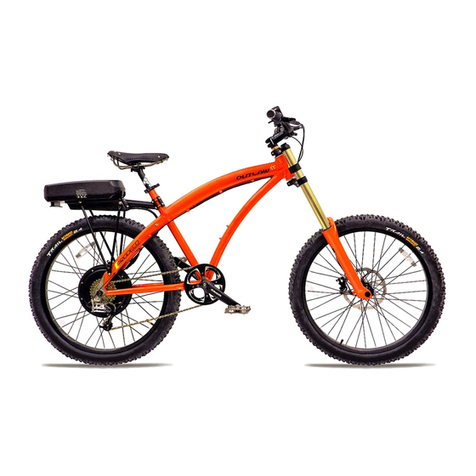
Prodeco Technologies
Prodeco Technologies Outlaw SE User manual

Prodeco Technologies
Prodeco Technologies Phantom X R User manual
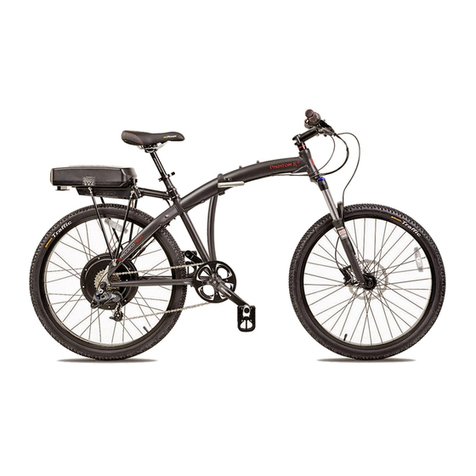
Prodeco Technologies
Prodeco Technologies Phantom X2 2013 User manual
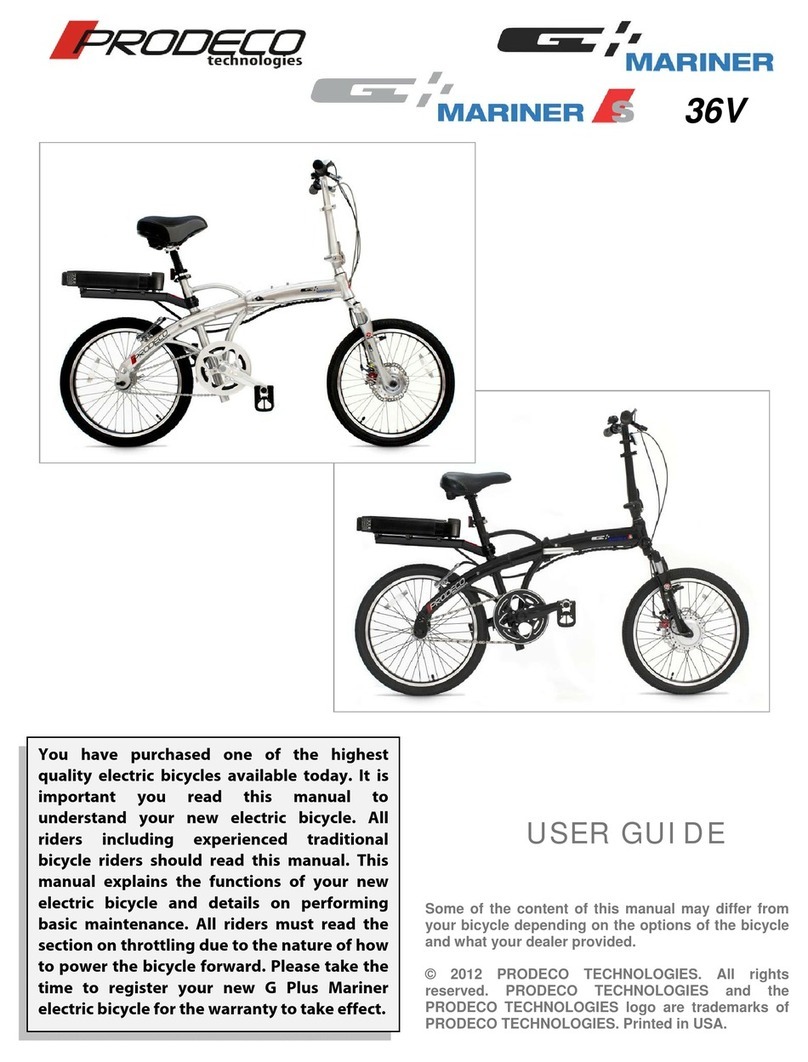
Prodeco Technologies
Prodeco Technologies G Plus Mariner 36V User manual

Prodeco Technologies
Prodeco Technologies Outlaw SS 2013 User manual

Prodeco Technologies
Prodeco Technologies G Storm User manual

Prodeco Technologies
Prodeco Technologies Men's Fitness User manual
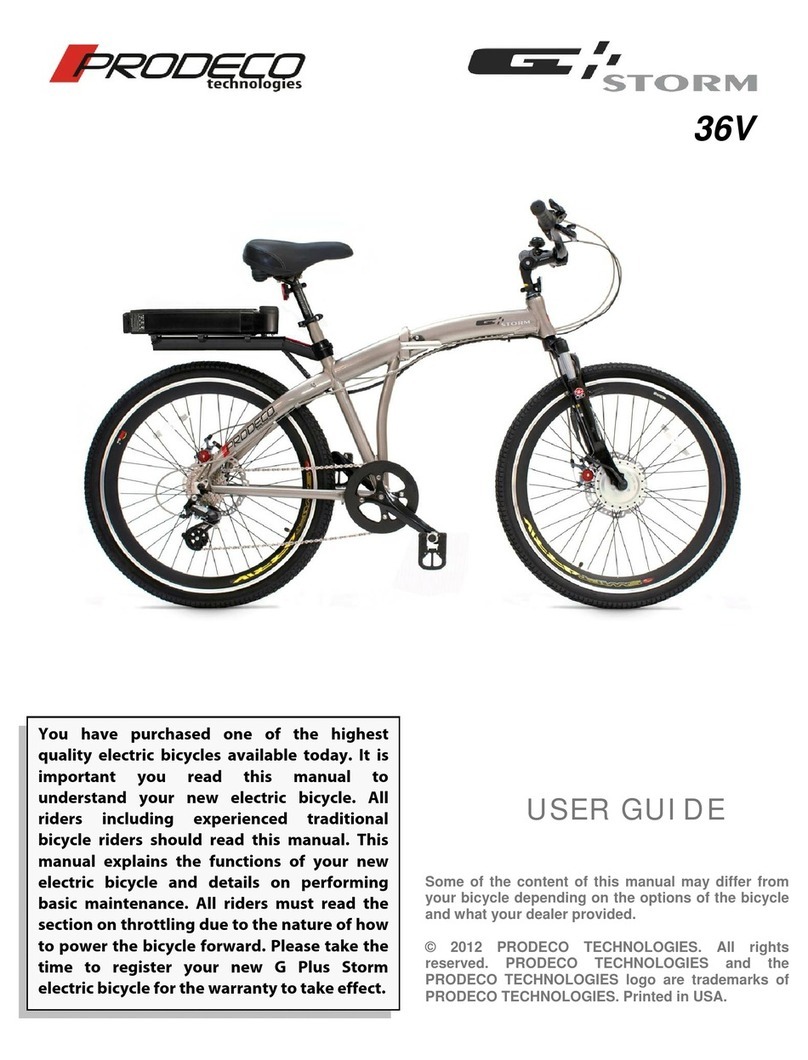
Prodeco Technologies
Prodeco Technologies G Plus Storm User manual
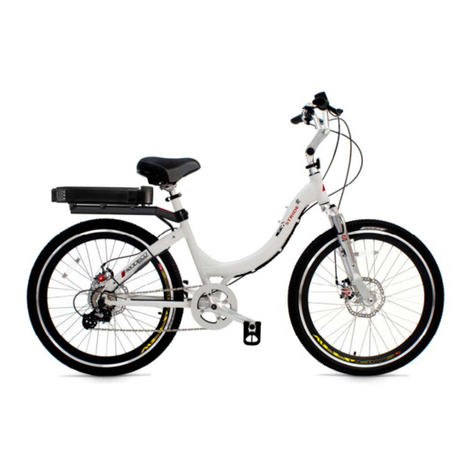
Prodeco Technologies
Prodeco Technologies G Stride R User manual

Prodeco Technologies
Prodeco Technologies Storm 2013 User manual

